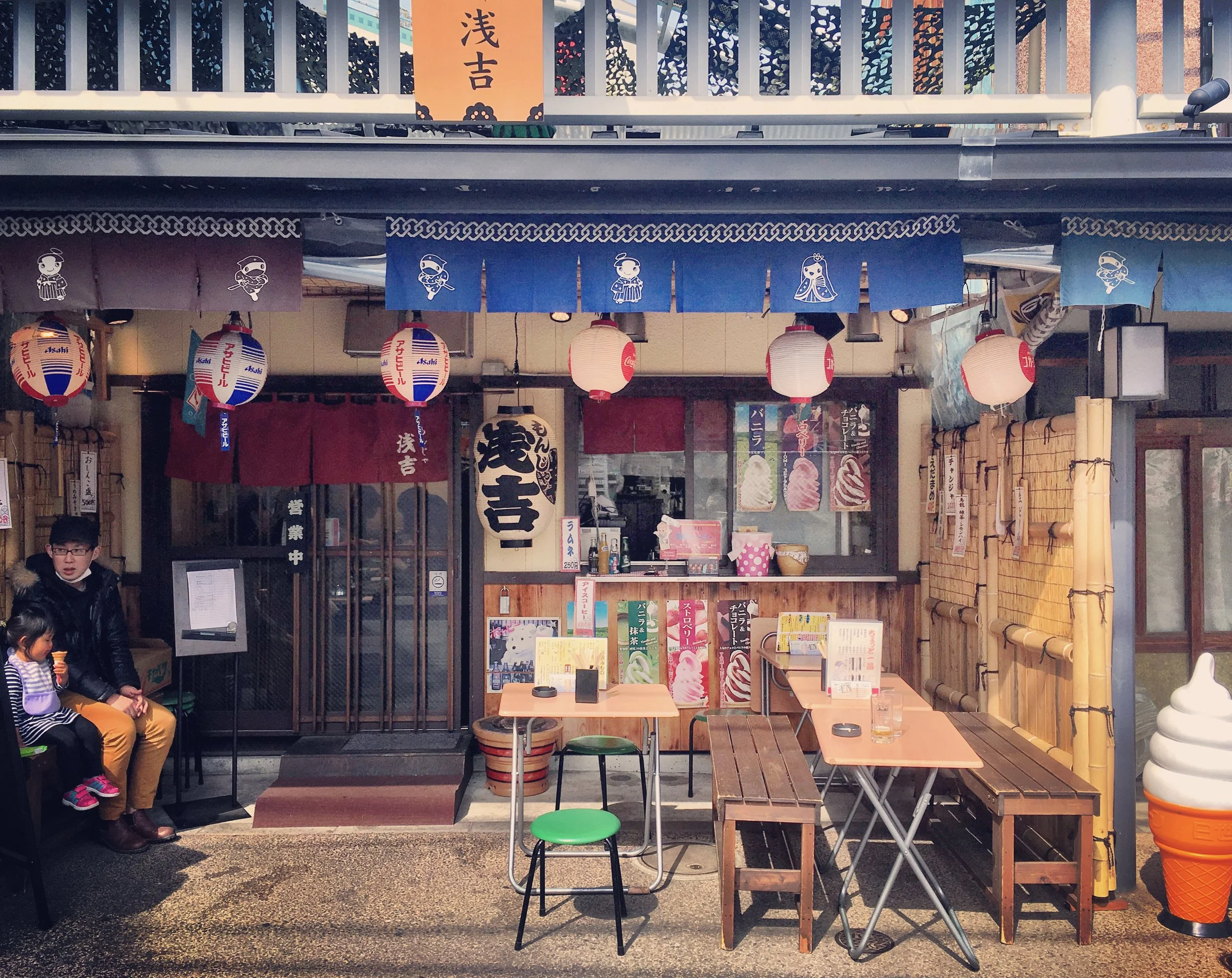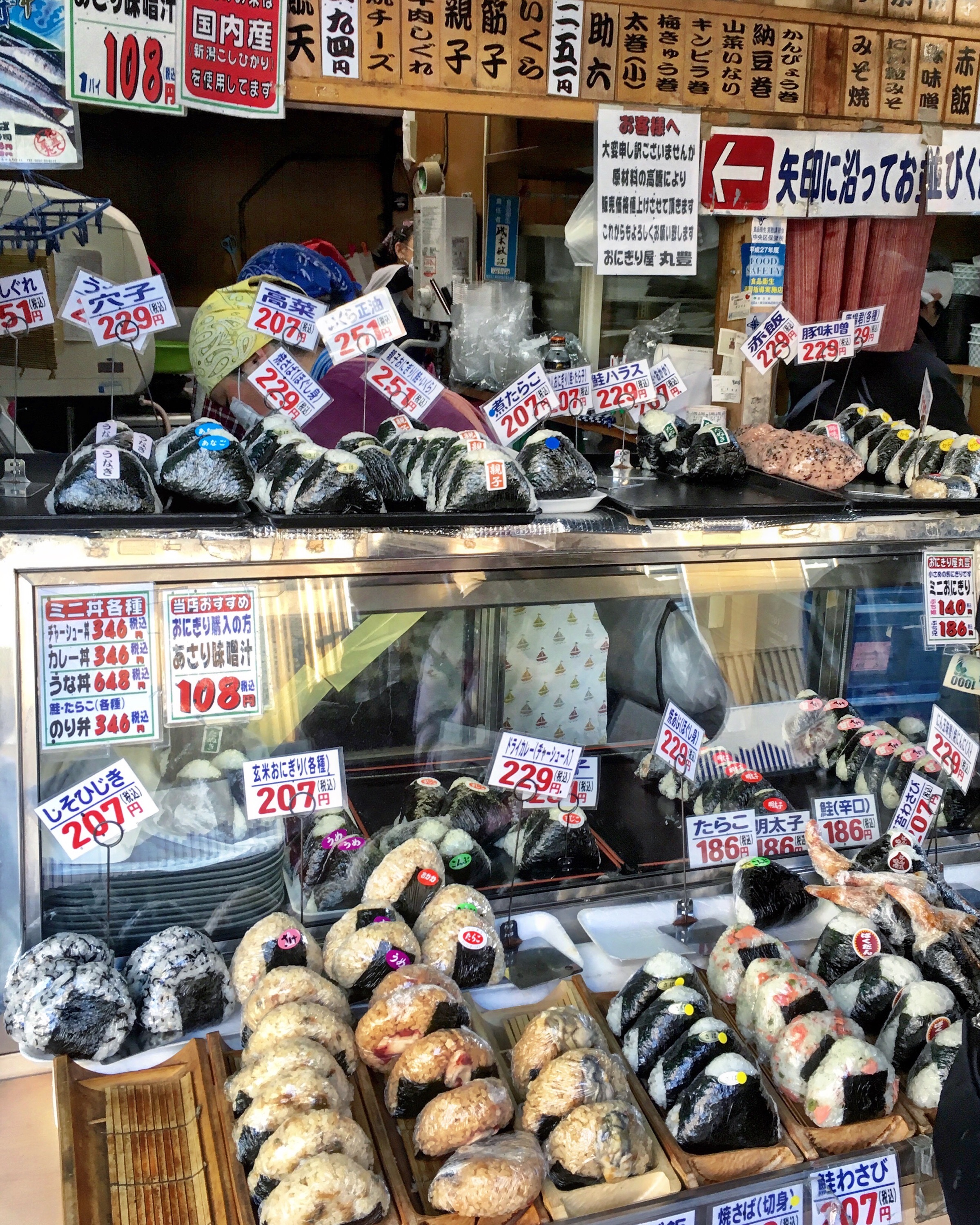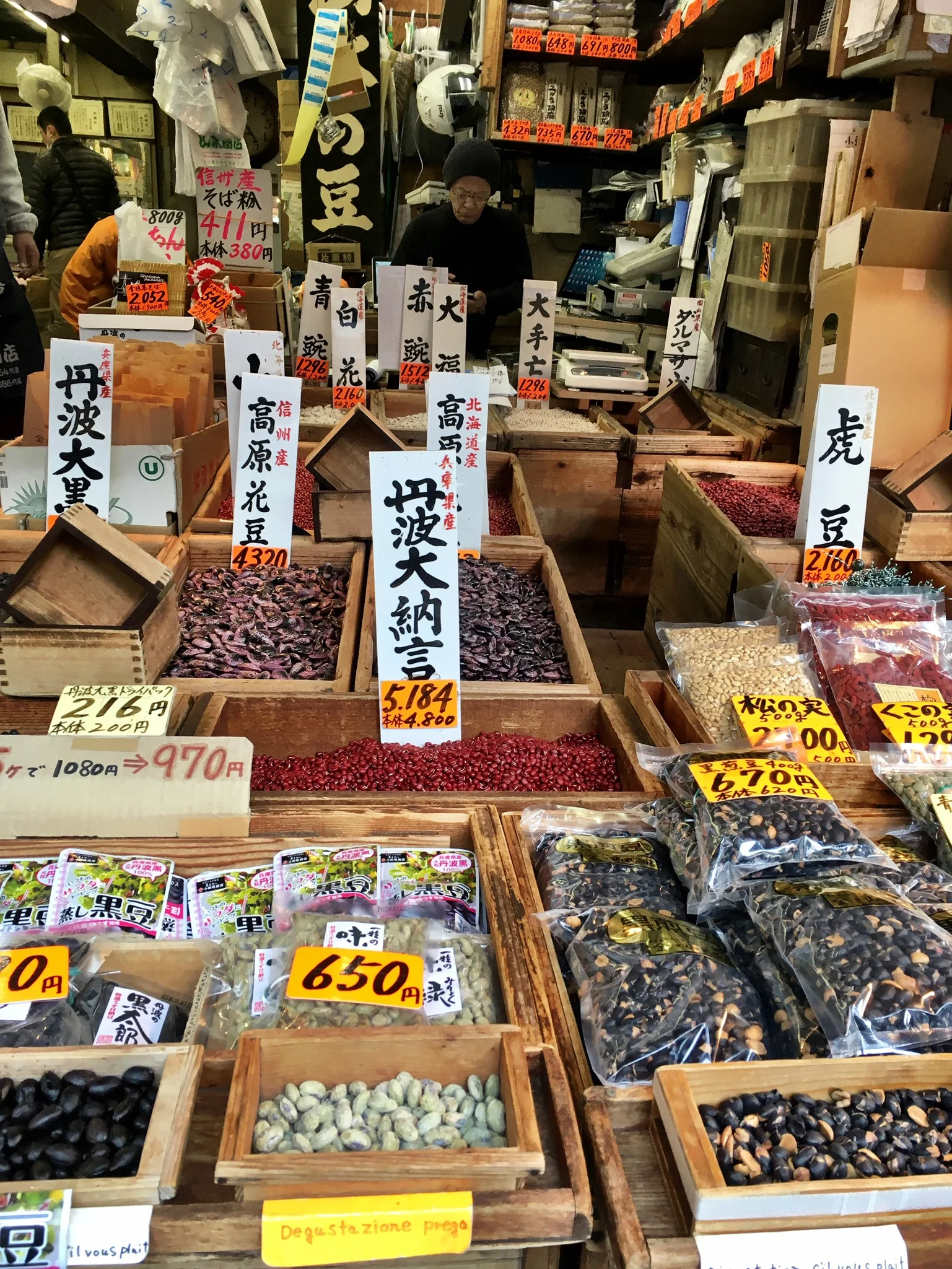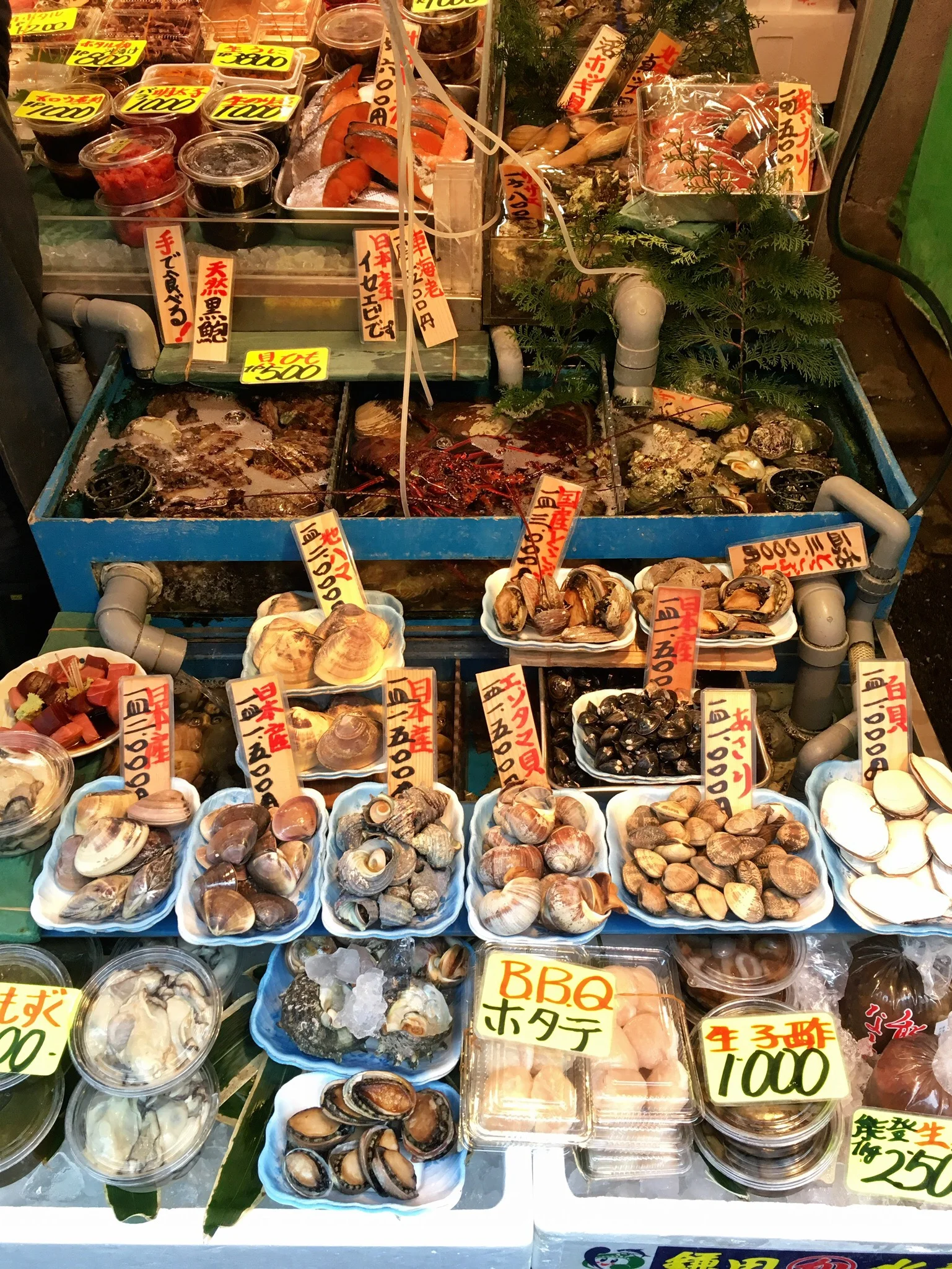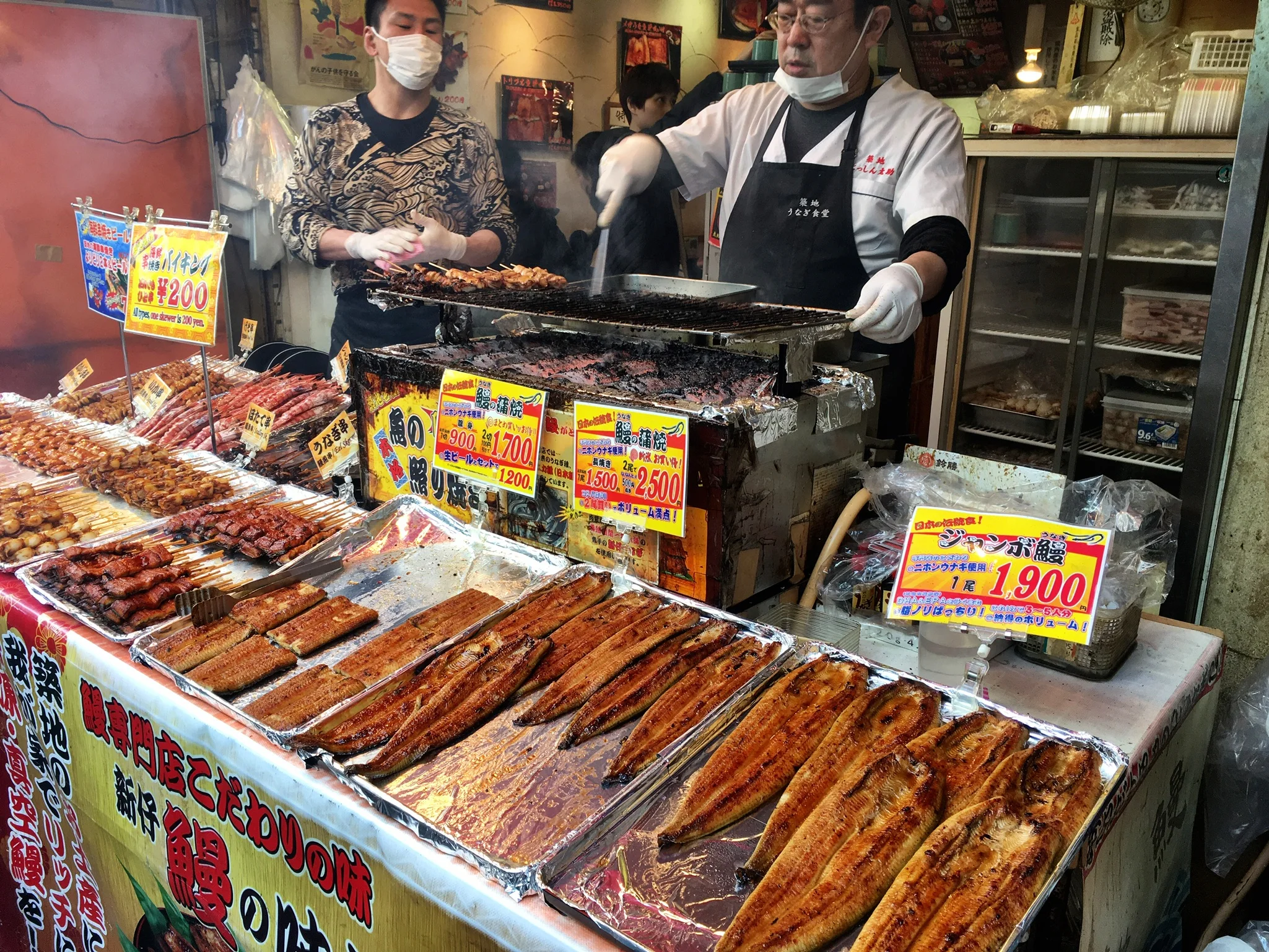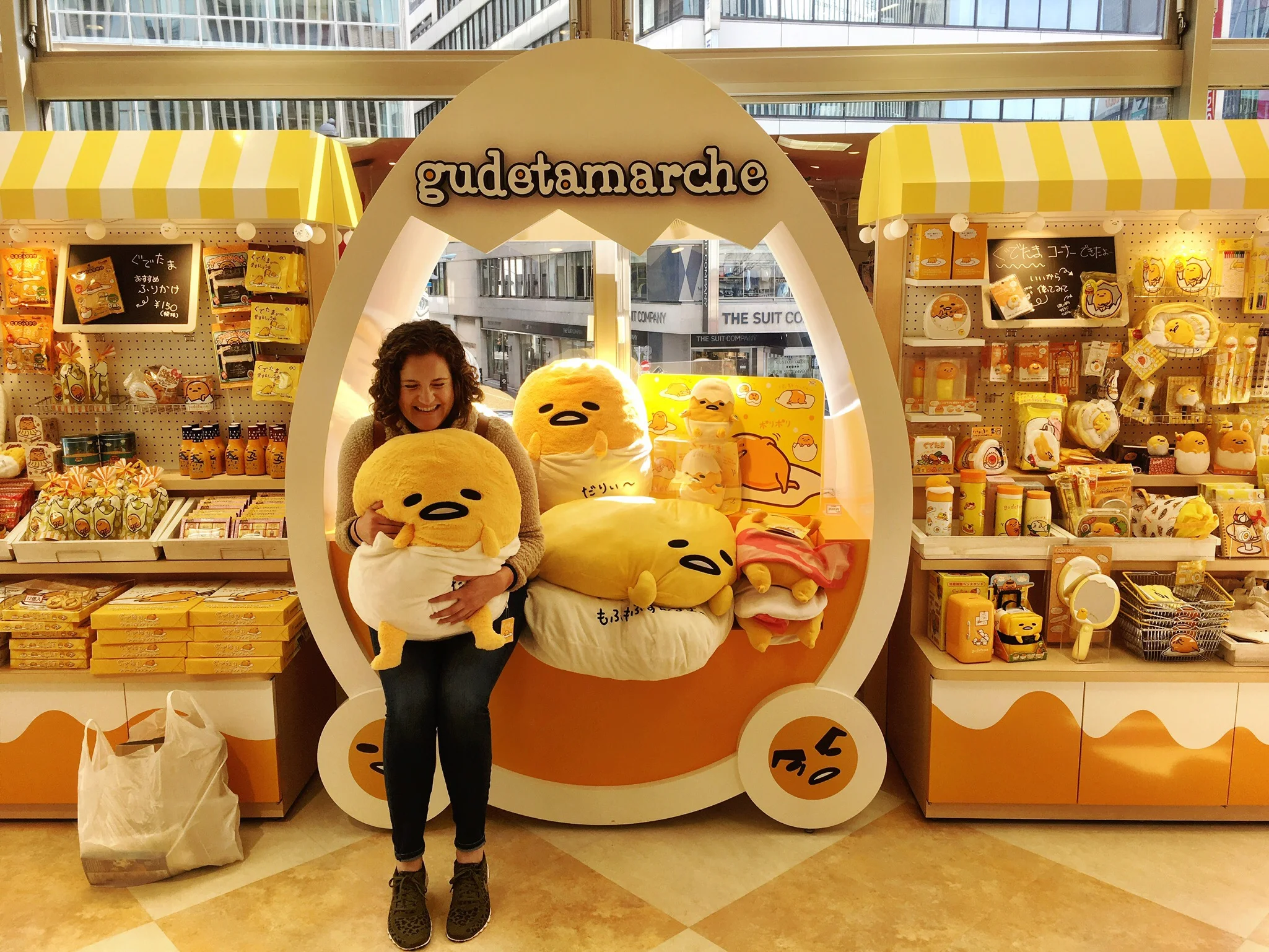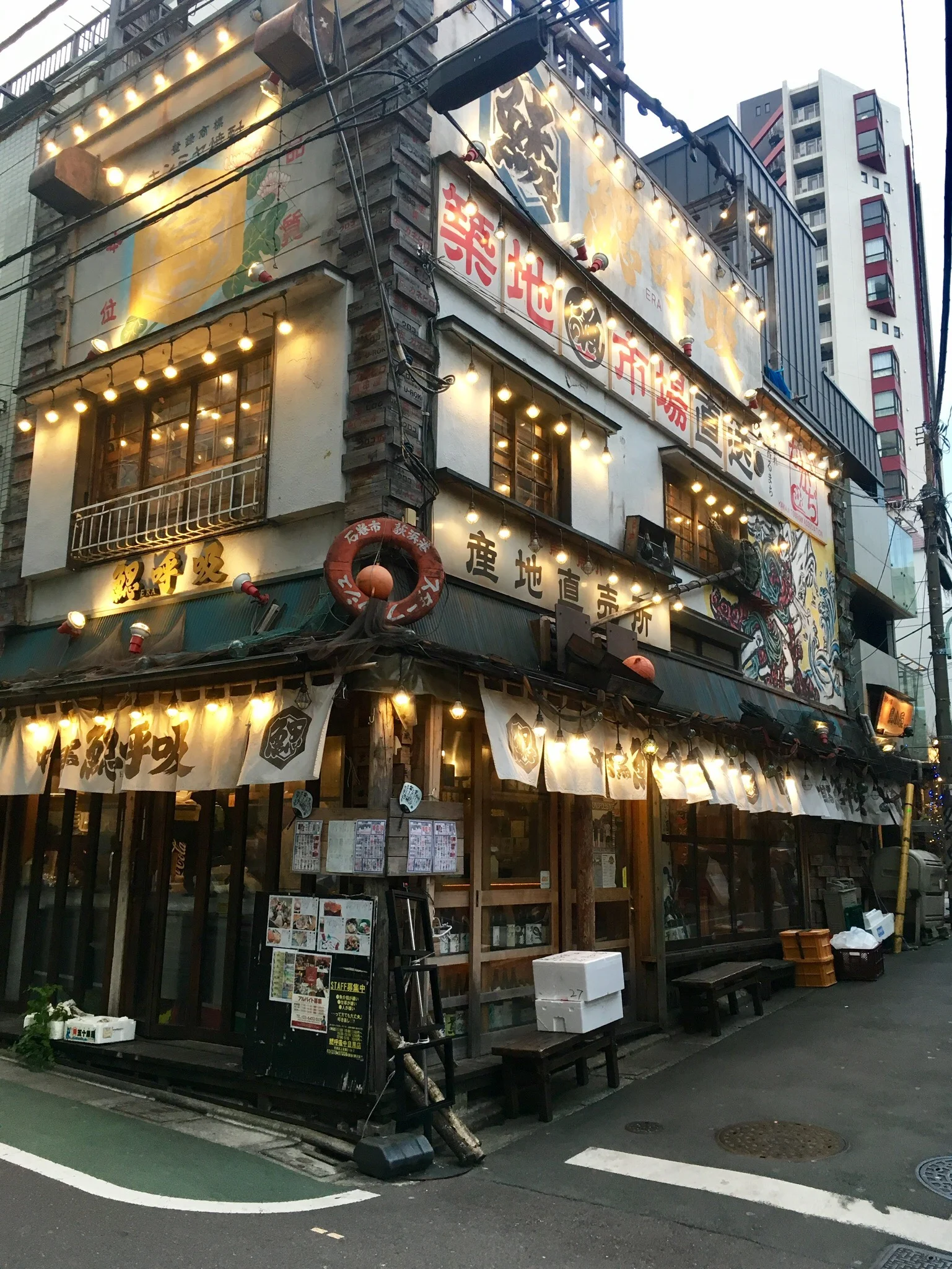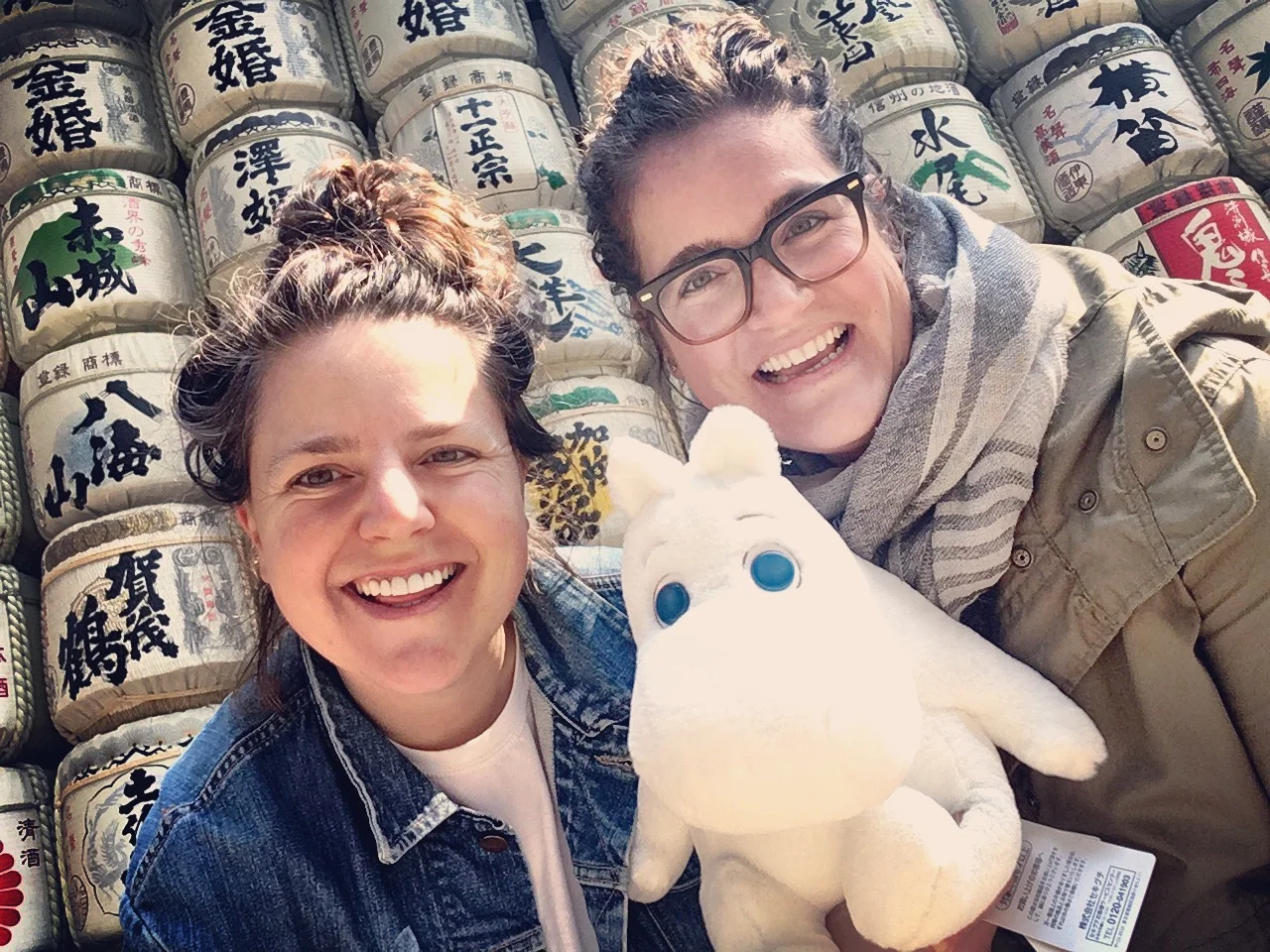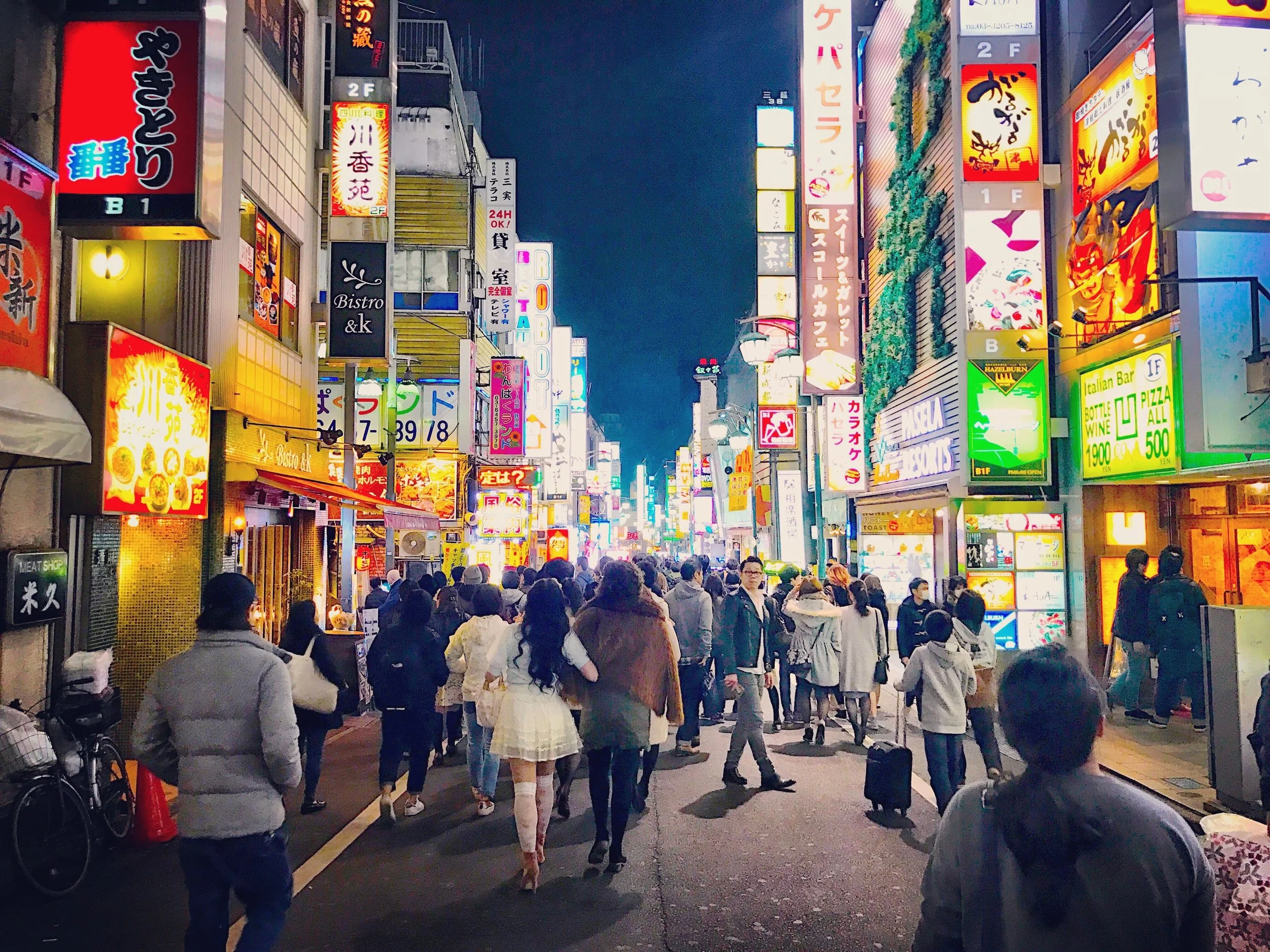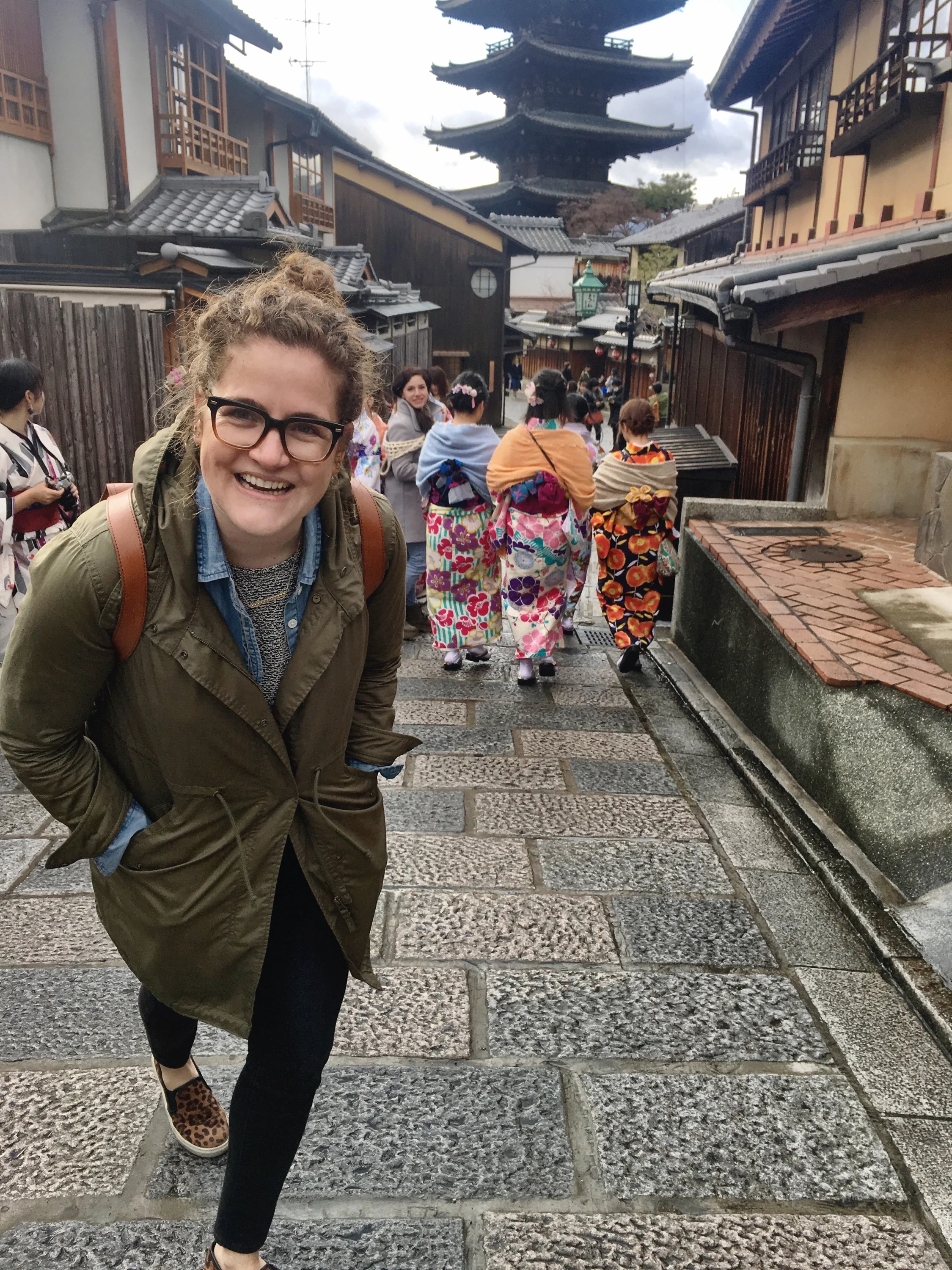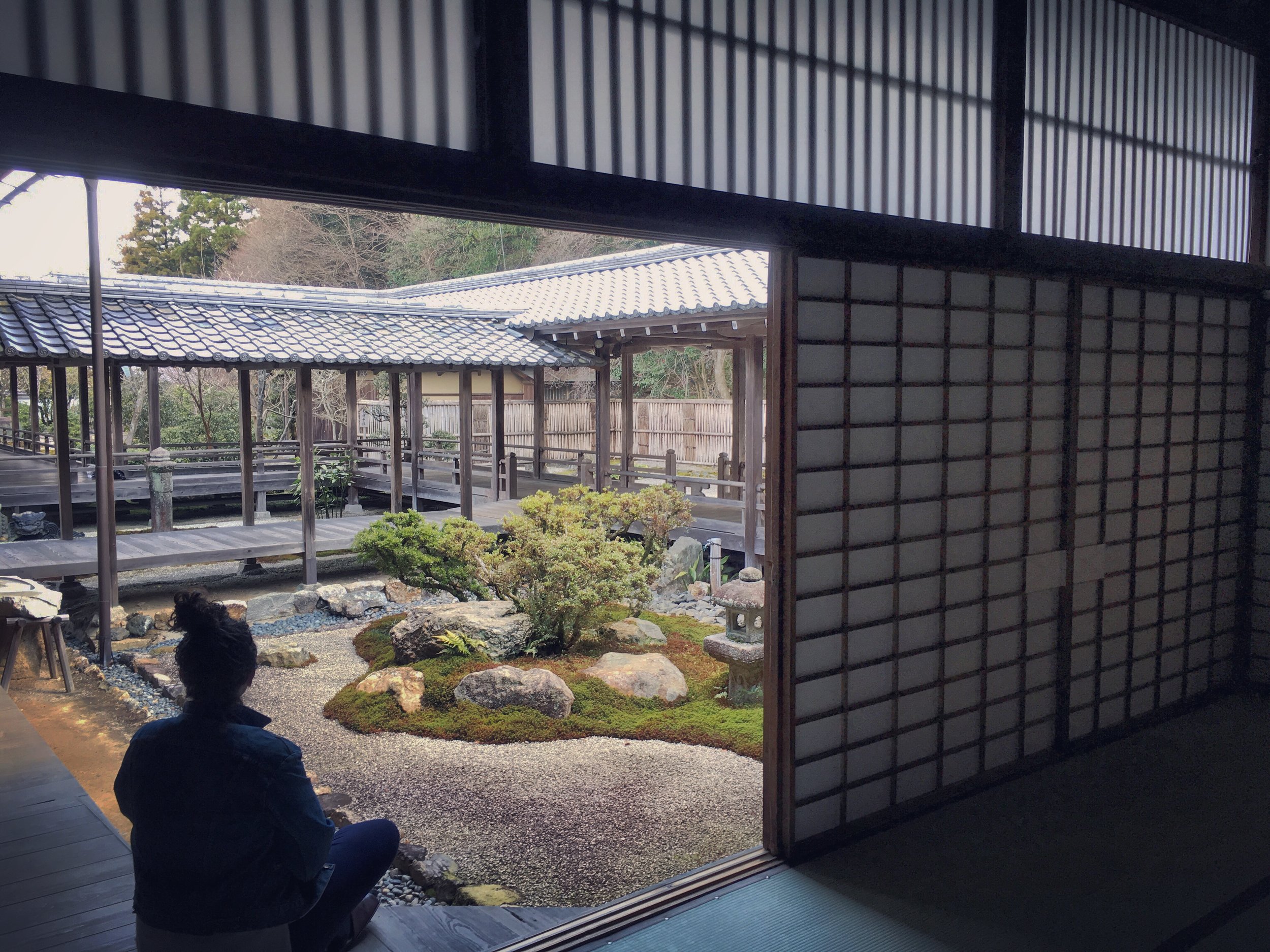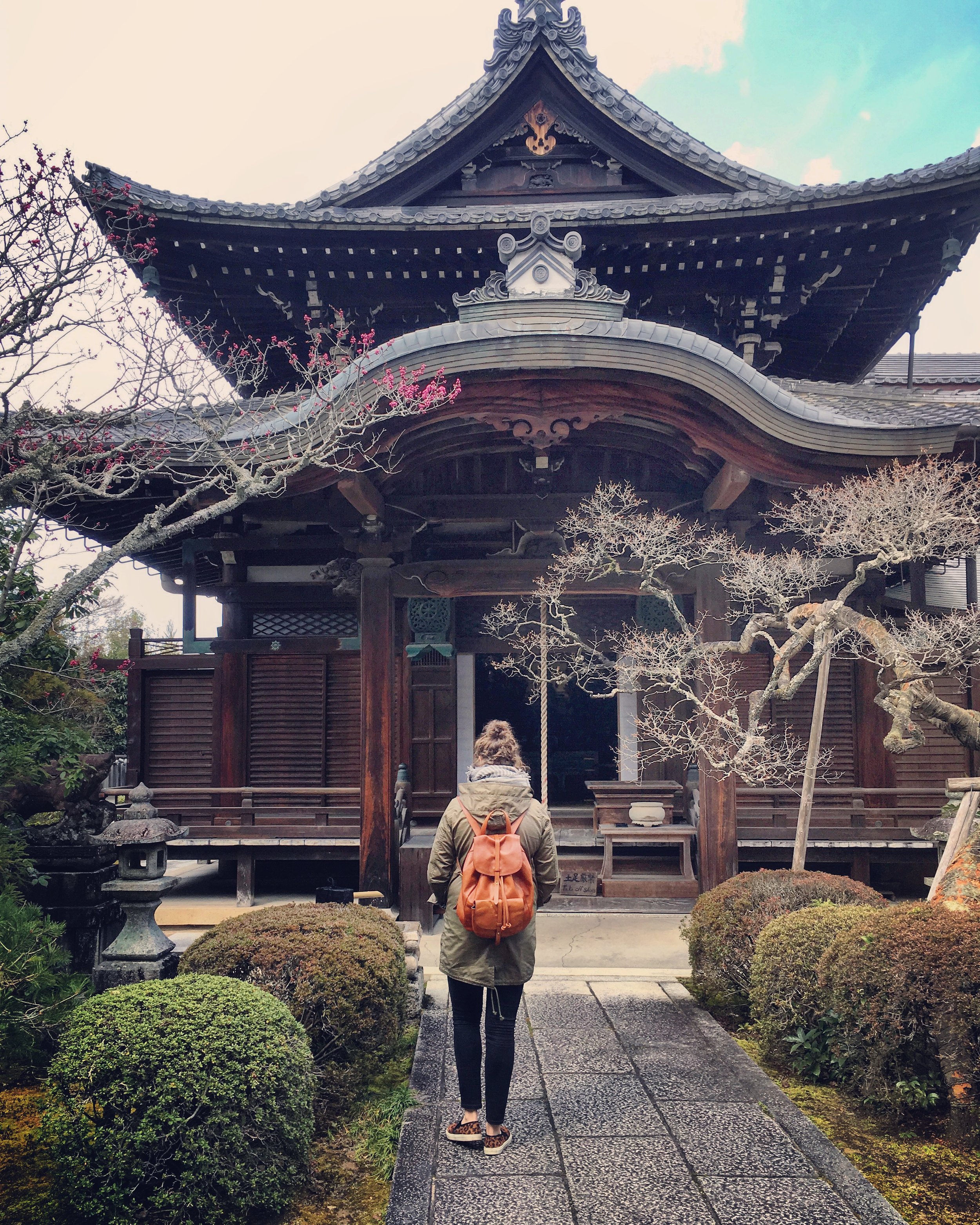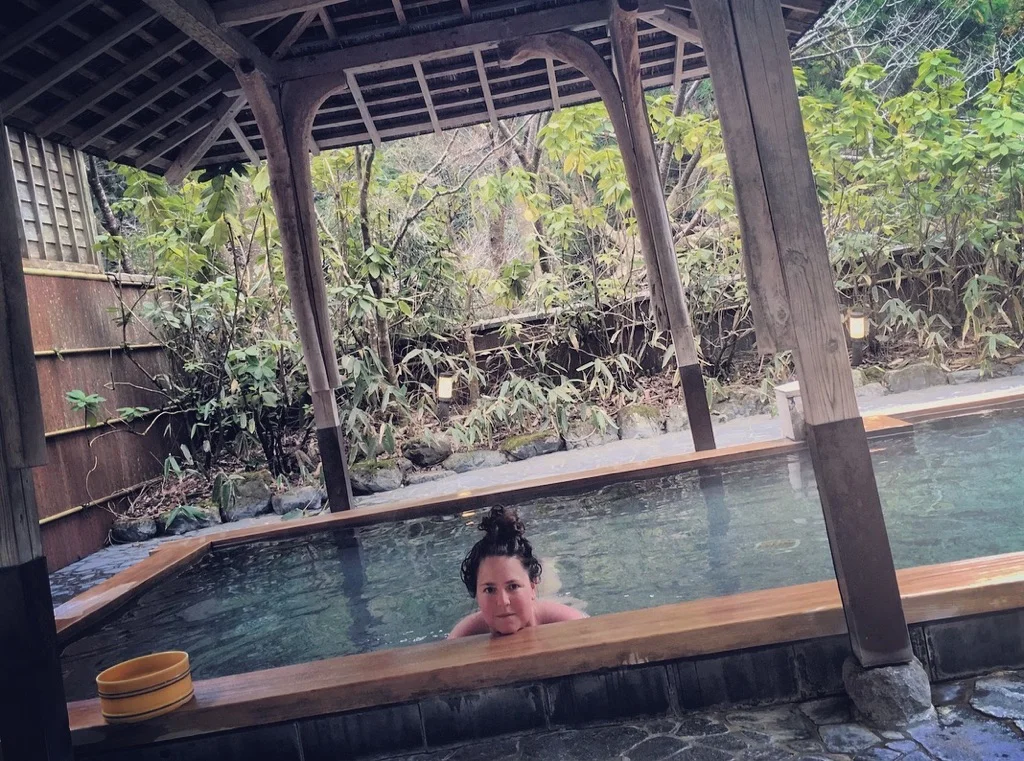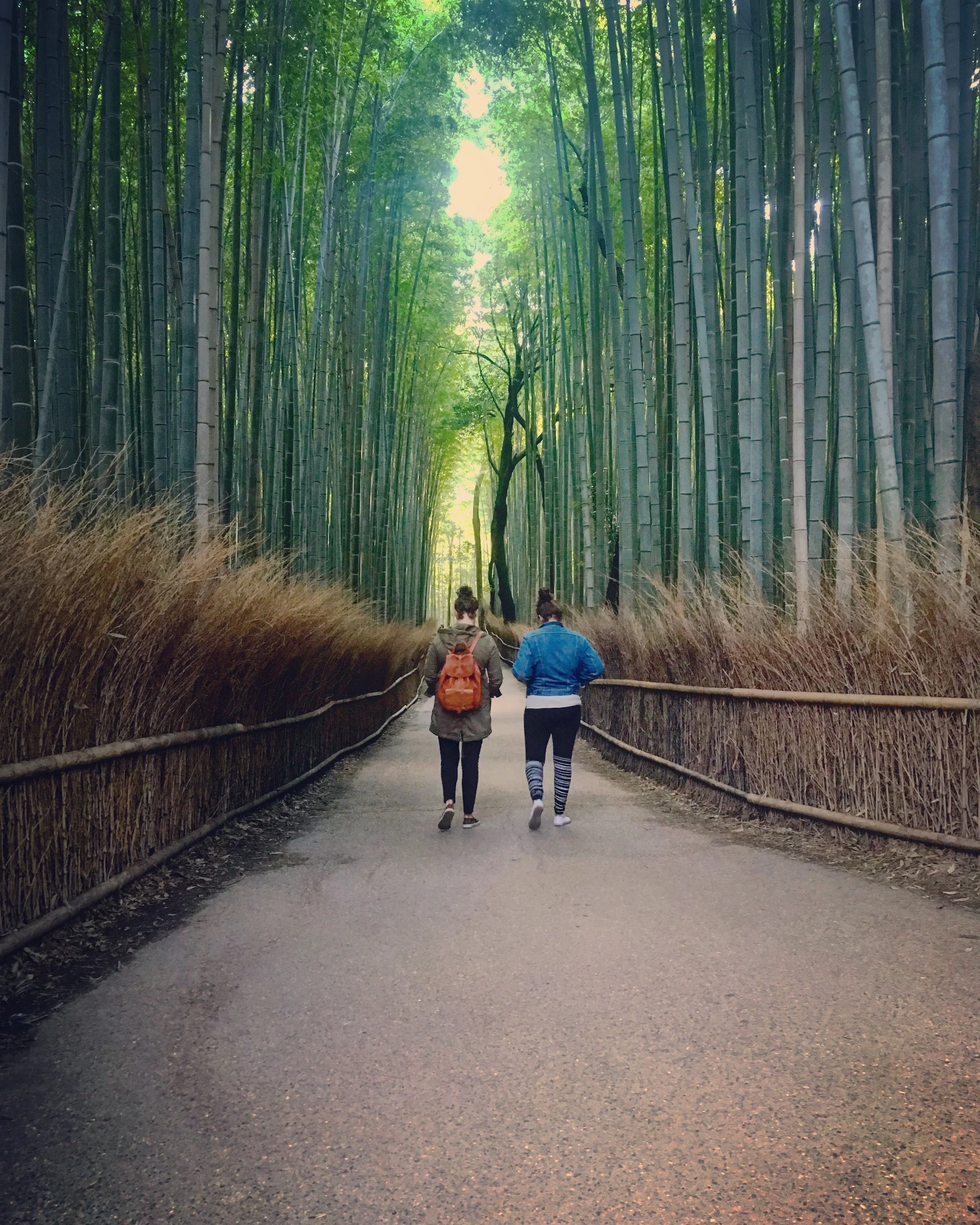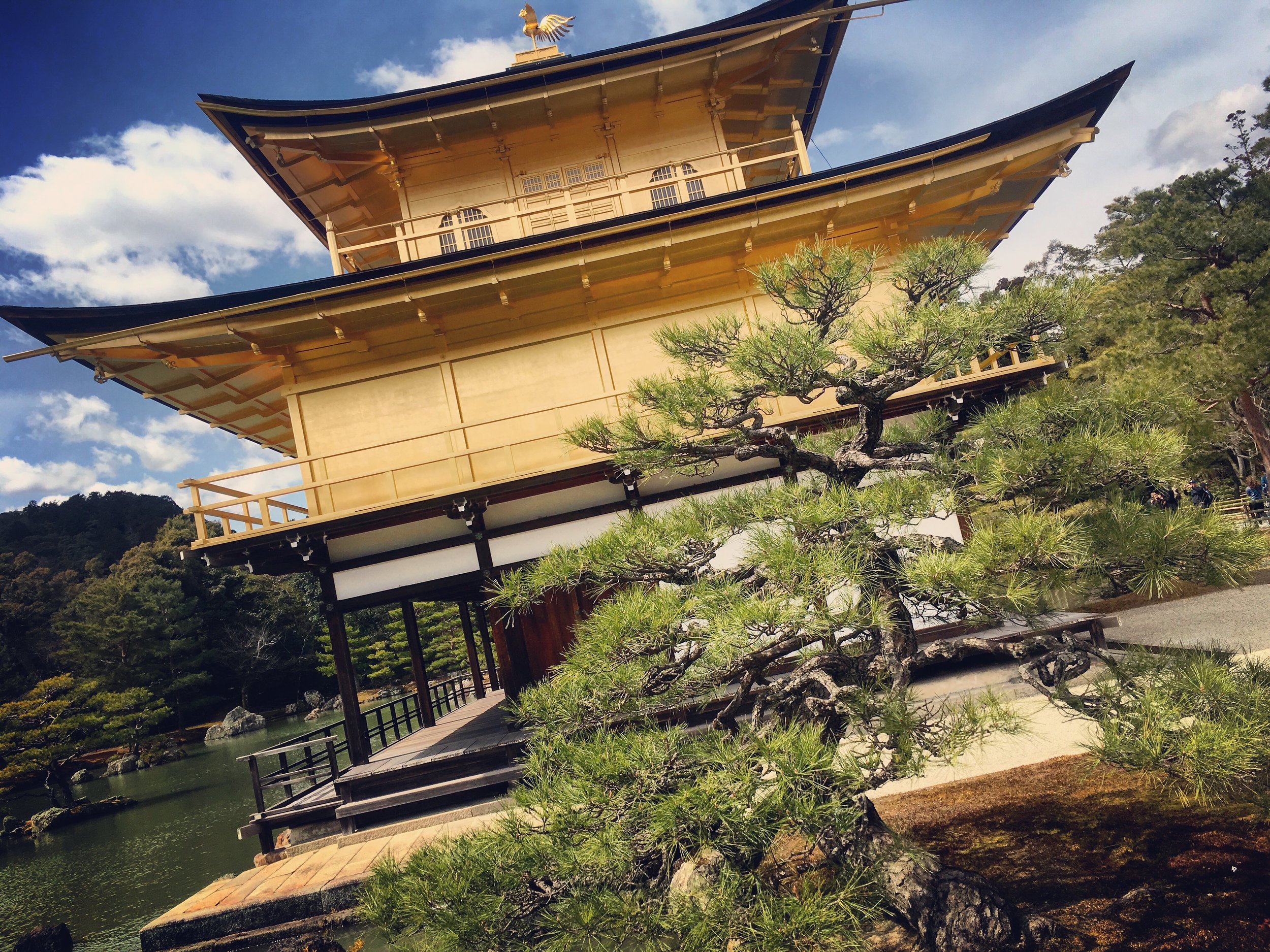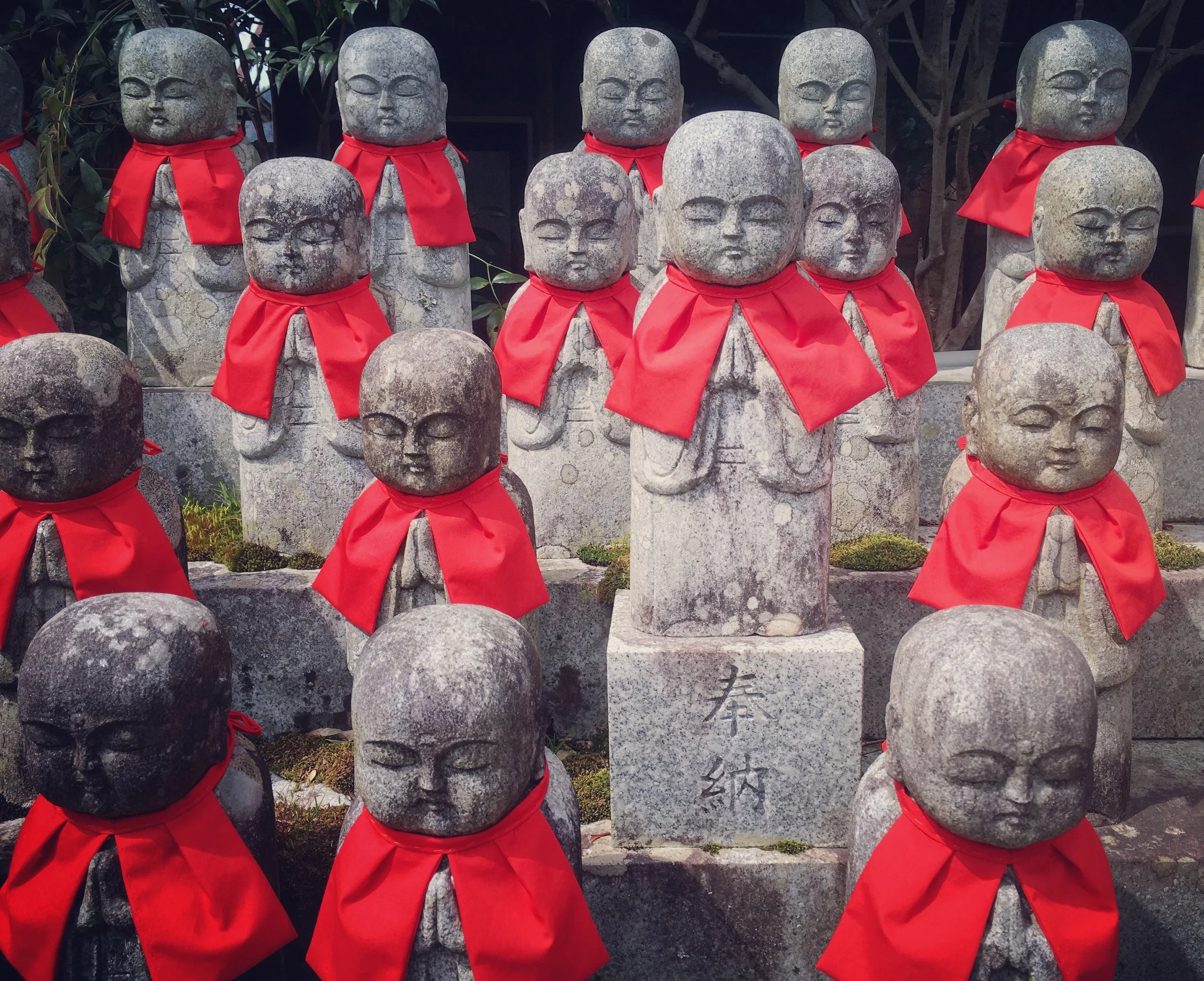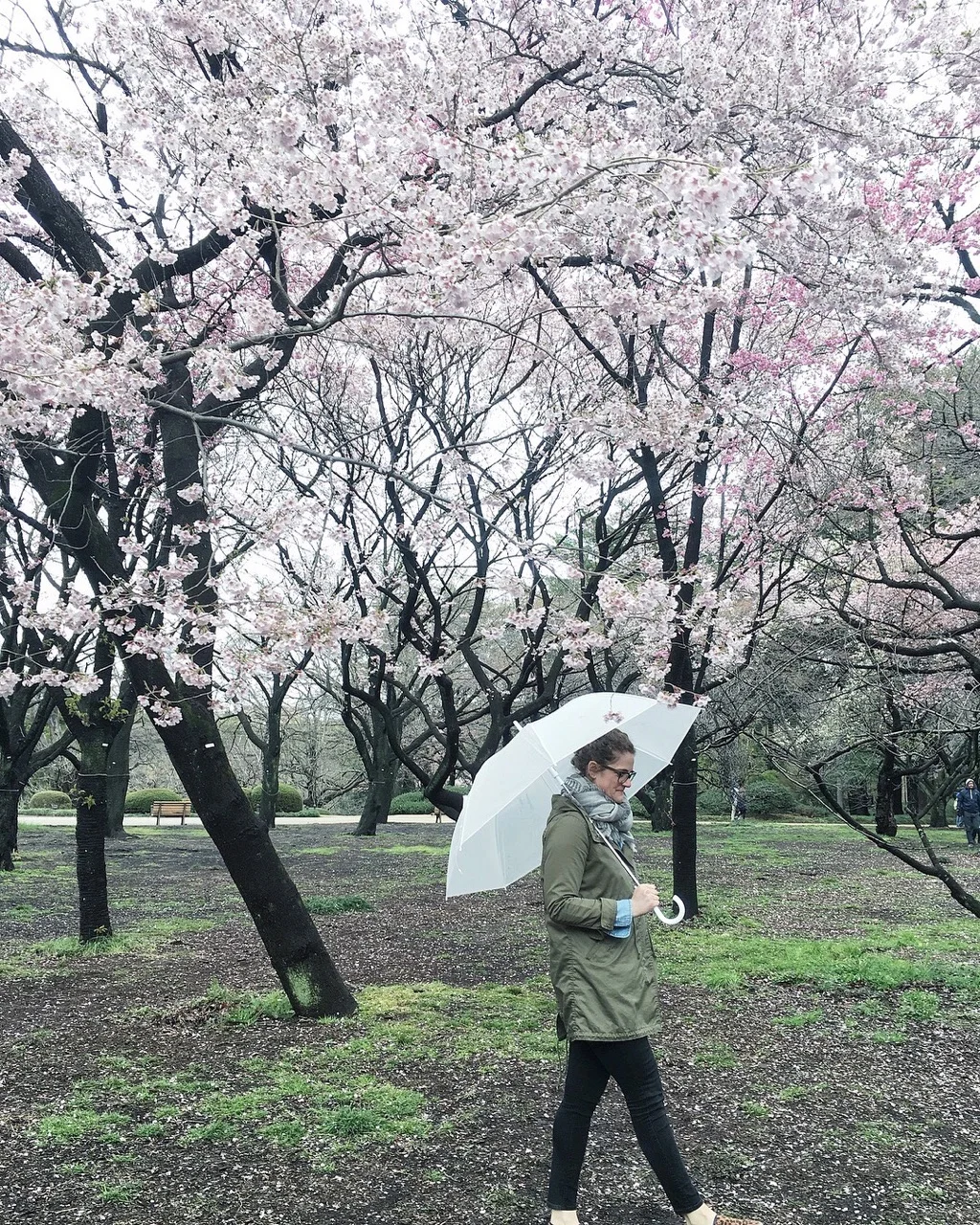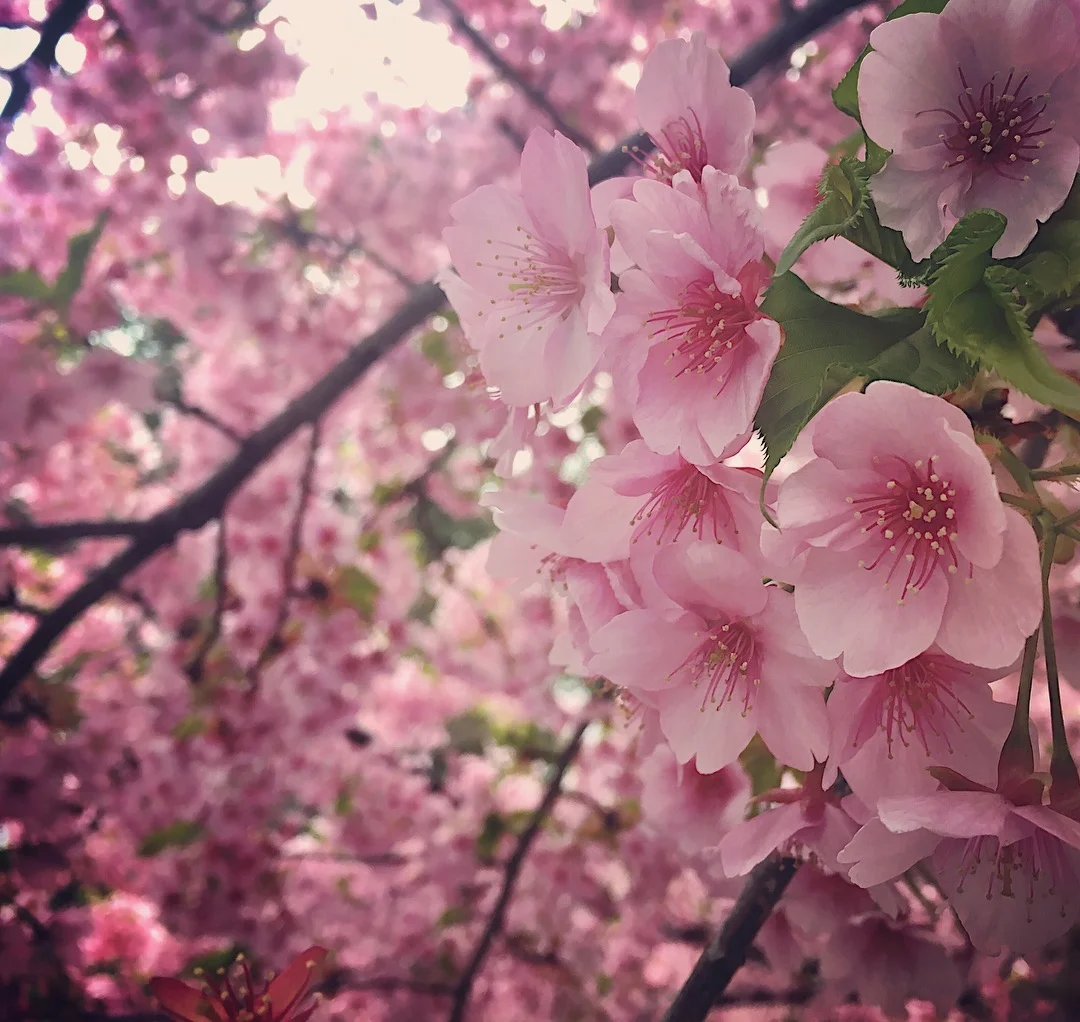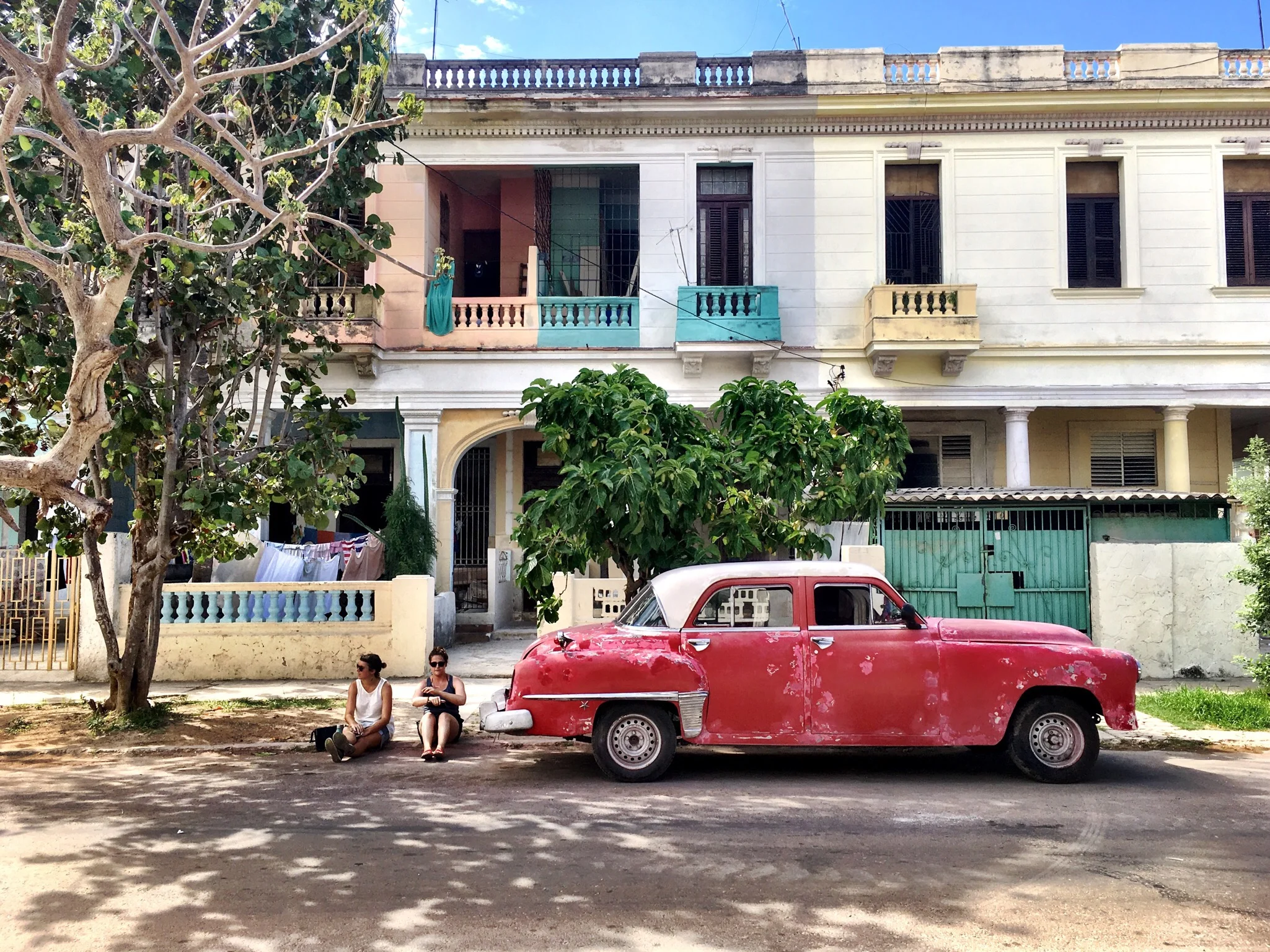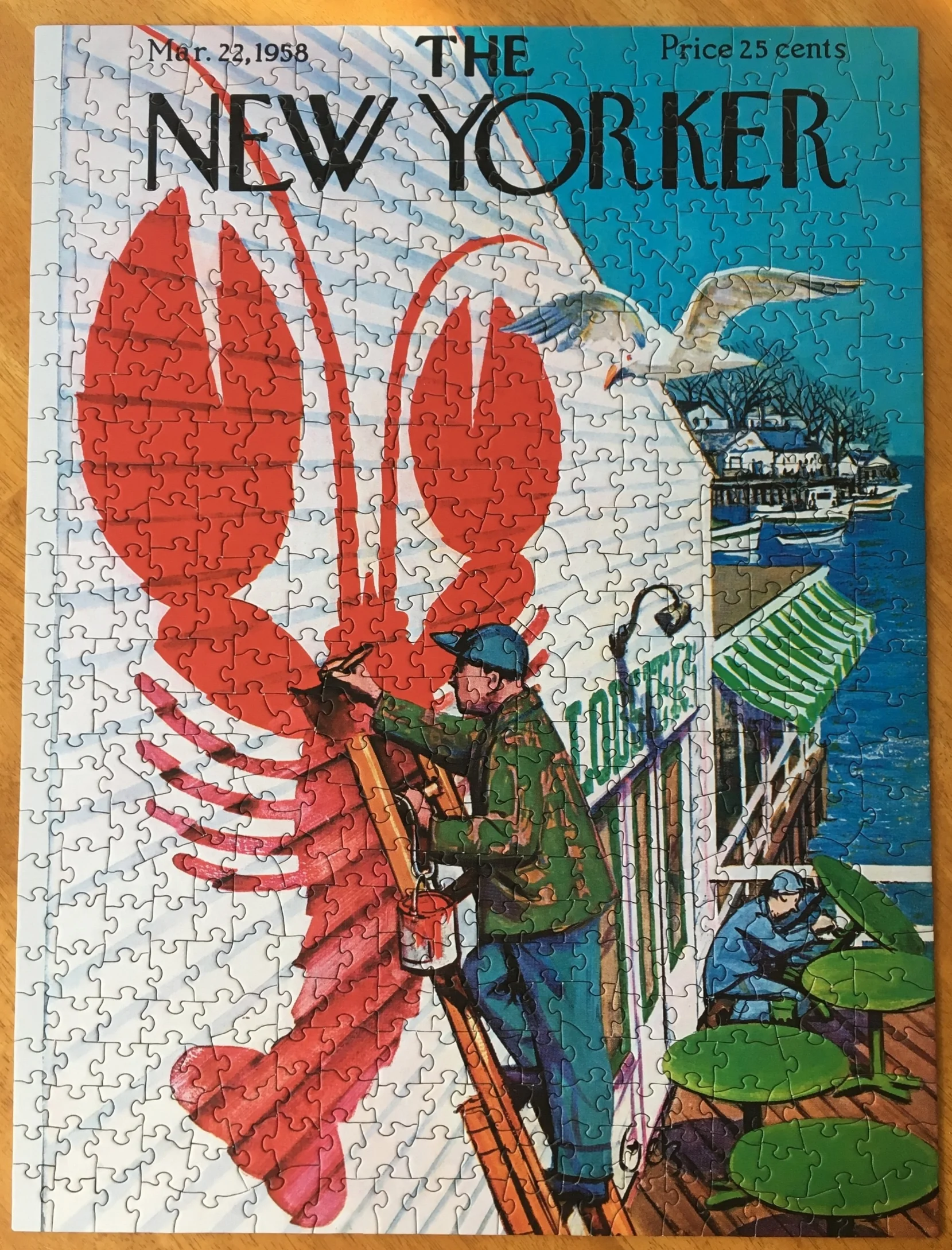Japan | March 2017
IN FLIGHT
Travel time: 20 hours (roundtrip)
Miles covered: LAX to HAN (roundtrip and nonstop!)
Movies consumed: twenty minutes of The Girl on the Train, one hour of the new all-female (gasp) Ghostbusters, Money Monster, The Devil Wears Prada, A League of Their Own (Delta’s entertainment system cut out during game seven of the World Series!), Everybody Wants Some!!, and two episodes of the guiltiest of pleasures, Vanderpump Rules
Hours slept: eight (roundtrip)
POST FLIGHT
Travel time: 11 days
Miles covered: averaging 10 per day on foot
Bowls of ramen consumed: 7
Currency: Japanese Yen (~111 ¥ to 1 USD). Most establishments are cash only, but some accept credit/debit cards. The 7&i Holdings (7-Eleven convenience stores) ATMs offer favorable exchange rates.
Prologue:
Like so many before (and more since), we came for the cherry blossoms. The spring bloom of which has long been celebrated as signaling the end of a cold winter and ushering in a new agricultural season. The Monday following our arrival is March 20, 2017, otherwise known as the Vernal Equinox (or one of only two days per year when daylight hours equal night). Carefully calibrated annually based on astronomical data, this day officially represents the change of seasons from winter to spring. Symbolically, it represents rebirth; the opportunity to begin anew. With the Autumnal Equinox, this day is recognized as a public holiday in Japan - a day off intended for literal and metaphysical spring cleaning. According to Wikipedia, “The holiday was originally a time to visit loved ones’ grave sites and pay homage to the ancestors. The Japanese would also take the time to renew their lives by cleaning their homes and making life changes such as starting or finishing school or a new hobby.” Our holiday pursuits - paying homage to restored restorative temples and cleaning our plates (or bowls) - are not entirely dissimilar.
The magical cherry blossom trees (sakura in Japanese) are admired for their brilliant but short bloom season (becoming ever shorter each year), a natural process and, naturally, a metaphor for human life. Arguably, the only thing more perfect than the blossoms themselves is the beauty with which they echo the teachings of Buddhism, particularly the concept of anicca or impermanence. According to Buddhism, impermanence is an undeniable and inescapable fact of human existence from which nothing that belongs to this earth is ever free. Impermanence and the inevitability of change are thus undeniable truths of our existence. It is by becoming aware of these truths, by observing and understanding, one can find a remedy for the sorrow of human life and, thus, become liberated from its constraints. In this way, followers of Buddha avoid attachments to the material world and recognize that all earthly delights, including themselves, are ephemeral. At the intersection of religious dogma and cultural aesthetics is Wabi-sabi - the Japanese worldview celebrating the beauty of impermanence and the inevitability of loss so epitomized by the cherry blossom.
Cherry blossom trees have also received prominent representation in Japanese nationalism and militarism. The trees were planted on military bases and soldiers were directed to “fight and fall like the cherry blossoms.” A fallen cherry blossom symbolized a fallen samurai who sacrificed his life for the emperor. During World War II, the symbolism of the flowers reemerged when painted on the side of kamikaze warplanes.
In Japan, it is said that the time of year can be divined from the seasonal blooms. Plum blossoms appear in March; cherry blossoms bloom in early April; lavender flowers mark the months of July and August; and ginkgo memorably turns fiery orange by mid-September. Time is told, but that is not to say it listens. Despite our will and protestations, time ticks on unconcerned with the desires of mere mortals. And unlike the oft-seen bakery shelves perpetually stocked and stacked with breads and buns, there is never enough. Some believe time is synchronic rather than sequential - that everything has already happened and the notion of time is a function of the brain’s ability to process and perceive the information rather than a series of unrelated events. For example, I have squandered a lazy Sunday in what seemed like an instant, explored nearly every neighborhood in Tokyo over the course of the longest day ever, and essentially lived March 28, 2017 twice (a la Groundhog Day) when my 9-hour flight home encountered a 16-hour time difference. Nothing in this life lasts forever (except maybe one’s self-conscious online presence), and so, with the equinox upon us and Wabi-sabi serving as inspiration, we begin.
第1章:
After eleven hours and fifty-five minutes airborne, we land at Haneda International Airport. We clear customs and immigration, withdraw ¥ from the terminal ATM, and continue to the Japan Rail office. We purchased 7-day rail passes online prior to our arrival, but must exchange the vouchers for official passes once in Japan. These passes are expressly meant for tourists and as such must be purchased outside the country. Our particular passes are scheduled to go into effect in a couple days when we travel to Kyoto, so for now we must brave the subway system to our accommodations in the neighborhood of Nakameguro.
Unsurprisingly, the Japanese subway system is fairly easy to navigate; the trains and stations are immaculate. We take three trains to Nakameguro Station on the Hibiya line. The lines are color coordinated and the stations numbered for a user-friendly experience. This was the most complicated of our public transit experiences, since we had to make several transfers with our luggage, and were unsure how much to pay to reach our final destination. We arrive at our accommodations around dusk. Our airbnb is located on the most adorable street, illuminated by colorful paper lanterns. The lampposts are adorned with fake plastic cherry blossoms in preparation for and anticipation of the upcoming bloom and accompanying festival. Our small apartment is plain and perfect with three beds, two bedrooms, a split level bathroom and small kitchen area. Amenities include wifi internet, a washing machine, balcony and complimentary slippers. We are exhausted from the long flight and 16-hour time jump, but decide it prudent to stay up, adjust to Tokyo time, and explore the city!
Tokyo is huge and crowded and comprised of several distinctive neighbors. We just scratched the surface during our visit, but the hip and relaxed Nakameguro was my personal favorite. This evening, we stretched our legs and got our bearings by walking to the neighboring district of Ebisu. We intended to eat at Ebisu Yokocho (neon rainbow entryway), which is this really lively food arcade repurposed from an old apartment complex. As a strong proponent of local, unassuming eateries, I loved the look of this alley of restaurants, but it was difficult to find seating at the crowded tightly-packed tables and likely even more difficult to actually communicate with the waitstaff. So we ended up dining at a Lonely Planet recommended ramen restaurant called Afuri. The small counter - which enclosed the small kitchen area - seats about a dozen people. We insert money into a vending machine and make our selections based on pictures (no wait staff communication required!). The machine then generates a ticket that we hand to one of the chefs. We are given seats at the counter when three in a row are made available, and they promptly prepare our order before our eyes. The language barrier is a bit of an issue. We were able to get by well enough, but there were definitely some establishments we were not confident or proficient enough to frequent. English menus, plastic food models, photographs and vending machines helped immensely. Feeling sated and self-satisfied with our competency abroad, we take the scenic route home, passing the Yebisu Garden Place Tower and Museum of Beer on the way.
第2章:
Tokyo has excellent public transportation. Subways and trains can get you within a few feet of most major sights. Today, we purchase 24-hour metro passes for 600 ¥, which include unlimited train travel on the Tokyo Metro lines. These passes are most easily purchased (with cash and coins) from the station ticket machines on the day of travel. There is no need to buy in advance. This particular day pass is only valid on the Tokyo Metro lines and does not include the more convenient and direct Toei Subway lines. However, upon careful study of the transit map and a few detours, we manage to hit Tsukiji Market, Ginza, Asakusa, Shibuya and Harajuku all in one day. Tokyo Metro, of course, offers more inclusive combination passes, but this was the most economic, yet workable, option.
Like Jiro, we dream of sushi. Unable to sleep, we take advantage of jetlag and head to the world famous Tsukiji Fish Market (from Nakameguro, 10 stops to Tsukiji on the Hibiya metro line). For those interested in witnessing the live tuna auction, it is necessary to queue as early as 3:00 a.m. The metro does not start running until 5:00 a.m., so you will need to walk or take a taxi to the market. [In Japan, taxis are quite expensive. The city also offers Uber rideshares, but such apps require cell data, which we never have.] The auctioneer allows observers in around 5:00 a.m. Only 120 visitors are allowed each day. For obvious reasons, the action takes place in a refrigerated area so make sure to bundle up. Some say the tuna auction is not worth the time and effort (i.e. we passed on the lot); however, everyone can agree that the outer market - with its free samples, steaming pork shu mai, giant mochi, omelette kabobs, and breakfast sushi - is not to be missed. The market occupies about four square blocks just southeast of the Ginza district. The interior of the outer market is dense with sushi bars and stalls selling everything from seafood skewers and rice balls to dried squid and fresh mochi. Chefs expertly clean and fillet the freshly caught and bought tuna, while the massive severed heads sit on display. Sushi-grade fish is sold street side, but the day being cold and early, we opt for seats at one of the many sushi restaurants instead. All the fish is fresh and delicious, with fatty tuna the obvious standout. The other notable edible is the pork shu mai sold at a small stall in the market. Each piping hot dumpling (about $1) is served with a dollop of spicy mustard on a styrofoam tray and devoured immediately.
We venture over to the inner market but are not allowed in until after 10:00 a.m. This area is exclusively for restaurateurs and locals purchasing fresh seafood at wholesale prices. Given the craze and speed with which carts and forklifts are driven through the aisles, it is probably for the best that we are not permitted. The entire area remains a fully-functioning fish and vegetable market that was not intended as a tourist destination. [I guess I should mention that the Japanese drive on the other side of the road. So be aware that potential hazards will come from an unexpected direction.] Market security is quick to redirect any and all tourists to the crowded sushi stalls across the street, some notable recommendations are Daiwa Sushi and Sushi Dai. While most visitors flock to the area in search of seafood sales, there is also fun souvenir shopping to be had in the outer market area. I successfully bid on a pair of beautifully decorated serving bowls for about $10 each.
The worst part about eating sushi breakfast at seven in the morning is waiting for our lunch spot (and pretty much everything else in Ginza!) to open. We wander the streets and admire the incredible architecture and avant-garde window designs while waiting for Hyotanya to open. Ginza, known primarily for its high-end shopping and towering department stores, is walking distance from the market. The restaurant promptly opens its doors at 11:00 a.m., and there is just one item on the menu: unagi also known as freshwater eel. The freshly grilled steaks - portioned as small, medium and large - are served in bento boxes with rice, soup and a variety of pickled vegetables. It was our intention to share a meal in an effort to save money and our stomachs for further sampling throughout the day, but despite beating the lunch rush (we were one of three groups in the restaurant), the woman made each of us order or own meal. This was our first brush with this unfortunate policy, but certainly not the last. Many Japanese restaurants had food and/or beverage minimums required of patrons. The food, however, did not disappoint.
My love of Sanrio characters did not outlive my adolescence. There was a fleeting (wabi-sabi!) middle school phase wherein I collected the various pens and coin purses and planners, but I have not thought about Keroppi or Pochoco since the turn of the millennium. However, in Japan, these characters loom larger than life. Literally. A huge Hello Kitty greets visitors at the entrance to the flagship store, Sanrio World, located in Nishi Ginza Department Store. Besides Kitty, Little Twin Stars and Cinnamoroll are the stars here. But I had a real soft spot for Gudetama, this strange little lazy egg character, who apparently finds life to be almost unbearable. The mascot’s colorful day planners and greeting cards feature him in various states of exposed repose (for Gudetama has a well-defined bare buttocks): blanketed by breakfast’s other favorite protein, bacon; marinating in miso soup; being poked and prodded with chopsticks; or dressed up as notable artists. Gudetama and his Sanrio friends served as my initiation to Kawaii - the quality of cuteness in Japanese culture. The commercially successful aesthetic, which showcases the emotional vulnerability of a people long-associated with stoic samurais, has suffused everything from handwriting to clothing to merchandise, i.e. emojis and pokemon.
From Ginza, we hop on the train (10 stops on Ginza metro line) to visit the Asakusa district and Senso-ji Shrine. Not to be confused with Akasaka (which I inevitably did while crafting daily itineraries), this area of “old Tokyo” is a bit of a tourist trap. That being said, entrance to the shrine is free. Once we hit street level, we are bombarded with hoards of people visiting Tokyo’s oldest Buddhist temple. A long, crowded shopping street leads from the outer gate to the temple’s second gate. Alongside typical Japanese souvenirs and snacks are sold. Being fans of snacks, we stop for melon pan, a melon shaped not flavored sweet bun halved and filled with whipped cream.
Stretching along the west side of Senso-ji is Hoppy-Dori, a small street named after the popular local “hoppy” beer-like drink. It has been a longtime haunt for a hard-drinking crowd of gamblers, but these days young Japanese and travellers are mixing the crowd up a bit. The signature offering of gyu-stews suji nikomi (stewed beef tendon) comes highly rated.
Once you stray from Tsukiji Market, the abundance of sushi bars drops significantly. We were just lamenting this fact and craving more sushi when we stumbled upon Sushi Go Round - one of those gimmicky conveyor belt sushi restaurants. The fish was actually quite good and reasonably priced. The amiable sushi chefs, making quick work of filling the gaps on the line, also accept special orders. Each place setting has powdered matcha and a hot water spigot to prepare your own tea. Beware: we quickly learned that each piece of sushi has a wasabi surprise tucked between the fish and rice!
We then walked to Oshiage (Skytree) Station on the Hanzomon metro line. Unlike most transit stations in the United States, Japan’s stations are often destinations in and of themselves. Tokyo Station is the prime example (see Kitchen Street restaurants and the intricate network of shops and grocers), but even the smaller stations will feature cafes, pharmacies and convenience stores. At Skytree, we stumbled upon yet another of Tokyo’s unique dining experiences, Moomin Cafe. We had known about Moomintroll for months before our trip. His large, expressive eyes as blue as the ocean we crossed to meet him. But finding him at Skytree took us wholly by surprise. We tried to get a seat at the cafe before noticing the long line queueing outside. This cafe also featured private dining rooms where Moomintroll would knock on the door and peer through the little window before being led inside by an enthusiastic employee. We desperately wanted to enjoy the company of Moomintroll and his extended network of family and friends, but decided it best to return early the next day.
We took the “Z” line to its terminus at Shibuya. Shibuya is famous for its shopping (Tower Records towering seven stories, 109 Shibuya) and its Crossing. Hundreds of people cross through the five-point intersection every signal. As evidenced by the loitering customers, the second floor of Starbucks makes for a prime observation deck. We post up for a few minutes to take a timelapse video of the iconic pedestrian crossing, which truly is quite mesmerizing.
From Shibuya, we walk north to Harajuku. Takeshita Street is unlike anything I have ever seen. The street is packed with people. It takes 30 minutes to traverse one long block. Most visitors are spectators, perusing the trendy boutiques, used clothing stores, and inexplicable crepe stands. But, of course, there are the devout few who frequent the area to purchase perfectly accessorized outfits. From colorful wigs and giant hair bows to patterned tights, every touch is thoughtfully considered and applied. To my eye, there are a variety of Harajuku aesthetics - schoolgirl, lolita, punk-rock, colorful and cutesy. Inspired by our surroundings, we transformed (or maybe reverted) to our truest selves: Syd grazing from bulk bins at Candy A Go Go, me waiting in a ridiculous line for frozen yogurt at Zaku Zaku, and Han finding her inner Harajuku girl by way of several choice ensembles.
One of the most fascinating things about Japan are its demographics. I particularly love California for its diversity. It affords the opportunity to encounter so many different types of people and cultures and, therefore, cuisines. In Japan, we consume mainly Japanese food (sushi and ramen and noodles and buns) with few exceptions. This is not surprising when we discover that 97% of Tokyo’s residents are Japanese. The remaining 3% are evenly divided among Chinese, Korean and other. This homogeneity is really shocking. But I must admit I do not mind eating ramen once a day.
Back in Nakameguro, we encountered some issues surrounding dinner. We assume most dwellings - with their hanging signs and glowing lanterns - are eateries, but figure it will be difficult for us to effectively place an order. Most speak little to no English and restaurants rarely have English menus. Tired and discouraged, I went to bed, while my more spirited travel companions forged ahead.
第3章:
During last night’s reconnaissance mission, S & H found a wonderful bakery in the neighborhood. As we come to learn is customary in Japan, The City Bakery is arranged cafeteria-style. There are small trays and tongs at the entrance for you to serve yourself. The locals pile their trays high with various baked goods before making their way to the counter. Our eyes as big as our stomachs, we grab a croissant, ham and onion pastry, and almond cookie, along with our coffees.
Yesterday’s unexpected run in with Moomin only served to heighten our anticipation. The Nordic character and physical embodiment of Kawaii was embraced by the Japanese, who built cafes to commoditize the brand. Moomin was billed as a cafe companion, someone to sit across the table from solo diners. Not wanting to take any chances on longer lines at the smaller cafe, we make our way to the Moomin House Cafe near Tokyo Dome City (with another 24-hour pass, Hibiya line to Ginza, transfer to Marunouchi line for final stop at Korakuen). The characters (near life-size stuffed animal representations) rotate from table to table. It was my understanding that Moomin would sit across from you at the table as a form of company. But most people are getting coffee with a friend or out with their children with Moomin and Co. joining as the third or fourth wheel. There is a short wait for our party of three. We are seated at a table set for four, and then place our order at the counter. Usually, the cafe offers latte art in his likeness, but that particular drink is not on the day’s menu. We nosh on coffee and cookies while Moomin and his friends rotate around the tables. The adjacent entertainment and shopping complex is massive. There is an onsen, roller coaster and log flume ride, and across the street is the baseball stadium where the Giants play.
After our meet-cute with Moomin, Han returned to Harajuku, while we headed across the street to explore Meiji Jingu Shrine. The location of Tokyo’s most famous Shinto shrine remains the city’s largest undeveloped space, serving as a peaceful reprieve from the hustle and bustle of the overly-crowded Harajuku and Omote-sando shopping areas. The grounds are open from dawn to dusk. Entrance is free. Displays of vividly painted sake barrels line the main entrance. The barrels, emptied of rice wine and filled with spiritual significance, are being offered as gifts to the gods.
Running perpendicular to the streets of Harajuku is Omote-sando, Japan’s famed shopping area. The Champs-Elysee of Tokyo. We briefly queued at Gyoza-ro (the Lonely Planet top choice for Japanese dumplings), but with the line barely moving we proceeded to the well regarded Maisen instead. A short walk from Omote-sando, this tonkatsu restaurant is delicious and well-organized. The line winds up the stairs before patrons are led to a row of benches and provided menus. You place your order with the front of house before being seated. Having just beat the lunch rush, our wait is about 15 minutes. The menu features different variations on tonkatsu, increasing in price based on size and cut of meat. There is bar seating downstairs. We are seated upstairs in an open room with low tables and seat cushions on the floor. Our meals cost about ~1700 ¥ for the smallest portion (but still large) of pork loin or filet, steamed white rice, all-you-can-eat shredded green cabbage, miso soup, and hot tea. The table is covered with dining accoutrement and assorted sauces. I would recommend the loin, which is juicier and more tender than the filet. When you have finished eating, you settle your tab at the front counter. The restaurant is a splurge, but a really great experience. If you are not able to make a seating at Maisen, they have a takeaway sandwich window next door and also sell their katsu sandwiches and bento boxes at some supermarkets and department stores.
The date is Sunday, March 19th but that does not stop the Japanese from celebrating the festival of St. Patrick. On our way back to the subway, we are greeted by a sea of green revelers and bands marching down Omote-sando. From there, we ride the train (Chiyoda line 4 stops to Yoyogi-uehara, and then a mile walk) to this hipster paradise called Shimo-kitazawa. Like all good hipster enclaves, this neighborhood is filled with coffee shops, vintage clothing stores, record stores and bicycle shops. We buy a phenomenal cornmeal donut from a street vendor and wander around.
With our phones and bodies in desperate need of charging, we stumbled into Brown’s Books & Cafe. The cozy store and cafe is located on the second floor above a holistic tea shop. The owner is really sweet and helpful. After she fixes our drinks, she sits behind the bar watching the televised sumo wrestling tournament currently taking place in Osaka. I also took the opportunity to peruse the shelves and invest in my first (and only) Japanese title, The Subterraneans by Jack Kerouac. Japanese books are read front to back, right to left, each line written vertically. [Note: Japanese two-prong outlets are compatible with American electronic devices, just a bit sluggishly given the difference in voltage. If you do require chargers or adapters, the Bic Camera stores located throughout the city are well-equipped.] At this point, we taxi back to Nakameguro and get ready for a night in Shinjuku.
Going in, we knew the robot cabaret would be cheesy and a bit lame, but it seemed like one of those things you just had to see. With tempered expectations, we made our way to Shinjuku, ready to embrace this once in a lifetime experience. Hearing that shows tend to sell out, we purchased our tickets online beforehand. Shinjuku is the Tokyo of your cultural touchstones: tall buildings, loud music, neon lights, karaoke bars, gamer arcades, and, at times, an overwhelming assault on your senses. As such, tonight’s entertainment is situated in the heart of it. At the entrance to the robot cabaret, we are greeted by two massive robot replicates. Rickety ladders lead to their laps where we pose for photos. We are led to an elevator that travels up several stories to a gilded staging area with a bar and band. The young female lounge singer is accompanied by a band of robots. Our entrance tickets also included one free drink, so we head to the bar before the show. Following an announcement, everyone walks down several flights of stairs, presumably to the basement, where the show will take place. There are three rows of bleachers on each side of a small middle area acting as the stage. Each seat has this little table and cup holder for concessions. Massive television screens, which are mounted on each wall behind the last row of seats, set the stage. Each act presents a different revenge fantasy in a new setting. Black-clad men are pushing/pulling the floats, while others follow behind the robot floats with handheld remote controls. Each act is separated by a ten-minute intermission, during which drinks and food are sold, and patrons can retread several flights of stairs to use the restroom. The show is ridiculous and ridiculously long. We stay for at least four of the intermissions before cutting out early under the phony excuse of a dinner reservation. The show is laughably low budget. But also frustrating in that we paid to see it.
From one tiny drinking den to another, we head to Golden Gai. This time trading in the robot apocalypse of the future for vestiges of Japan’s past. Golden Gai - the epitome of Tokyo’s postwar nightlife - is comprised of six tiny alleys lined by almost 200 tiny bars. Most can only seat four or five customers. Some places reserve seating for their regulars, while others welcome foreigners. The bars that display menus and price lists outside (some in English) are open to visitors. Albatross and Zucca are standouts.
If the line at Nagi (in Golden Gai) proves too long, there are plenty of other world-class dining options nearby. Tokyo is home to 12 three-Michelin-star restaurants. For something less sophisticated, “Piss Alley” is a fun option. Another relic of “old Japan,” Omoide Yokocho (literally “Memory Lane”) features small bars, yakitori grills, and food stalls. The specialties are charcoal-grilled meat skewers and a thick, hearty stew made of beef tendon and intestines. Vegetarian options are as scarce as seating at these tiny establishments. We decided not to eat here, but it was worth checking out.
On our way to the metro, we tucked into the well-reviewed Numazuko conveyor belt sushi restaurant. In retrospect, we made the grave error of visiting a conveyor belt sushi restaurant within thirty minutes of closing. The restaurant was fairly busy, but the chefs were no longer putting out new selections. So we were left to sort through the plates that had been circling the lazy river for an unknown period of time. Unimpressed and unfulfilled, we stop for a second dinner of ramen and gyoza at our local Ootoya. Last night (after I went to bed), S & H discovered this nearby restaurant serving above-average noodles and were excited to take me/revisit. The food was delicious. We sampled traditional ramen and gyoza, but their specialty is udon noodles dipped in a flavorful broth. We later learned that Ootoya is a chain throughout the city, but I still stand by this recommendation for tasty, affordable ramen.
第4章:
Japan is primarily known for its ceremonious tea parties, but change is brewing as the local youth embrace coffee culture. We found another great cafe by our apartment in Nakameguro. The barista at Onibus prepared a latte and single origin pour over coffee for us. There are several bean selections. There is outside seating, wood finishes, hanging plants, and succulents lending a California hipster vibe, despite the crisp bite in the air. Not accustomed to the chill of spring, we take advantage of the indoor seating in the loft above the cafe.
Things continue to perk up from there. Day four is marked by a monumental discovery that would appreciably impact the remainder of our trip: the Japanese supermarket. We buy lunch at Life Supermarket. It had an amazing deli with seared tuna and gyoza and tempura. Later that day, we found Tokyu store market, which had an even more impressive selection. We eat constantly. We must have frequented at least fifty 7-Eleven/Family Mart convenience stores during our 11 days. We sampled sushi and snacks, donuts and custards and cakes. All the sweets and desserts look beautiful and delicious. And then almost all are filled with this polarizing purple puree, which we later learn is red bean paste and a local delicacy. The highlights include mini glazed donuts, mini cheesecakes, onigiri, and a package of two small fluffy pancakes with butter and syrup contained between them. Absolutely brilliant.
After four straight days of indulging our taste buds (and closely monitoring pink cherry buds), exercise finally makes its way on the menu. Plus, a little jog is a great way to explore a new city. We begin running south along the Meguro River, stopping to admire the occasional cherry blossoms and some little leaguers fielding batting practice. We return to our starting point and continue north of Nakameguro Station. This section of the river is much more charming. There are cute boutiques and restaurants and cafes; dogs in matching dresses led down the brick paths; cyclists weave in and out of strollers; and cherry blossom trees actually are all around. Hot pink lanterns are being set up along the canal in anticipation of blossom season. Nakameguro is known for its cherry blossom festival when the time comes. The excitement in the spring air is palpable. Everyone gathers to artistically pose with and photograph the early bloomers. We cannot even imagine how magical it must be when they all blossom simultaneously. We monitor the official schedule daily. The current projections estimate peak bloom in about eight days. We will return to Tokyo for one final day in one week. We hope it will be long enough. We hope for warmer days ahead. We pray, just this once, that unmerciful time is on our side. The only thing we know for certain is that there is nothing to do but wait.
After a couple big nights out on the town, we decided to stay local. I was intrigued by this mysterious restaurant in Nakameguro. It was always packed with diners spilling out into the street. The chefs were constantly prodding and adding unknown ingredients to wells of hot liquid. Whatever it was, it smelled wonderful and I was eager to try it. We waited a few minutes for seats at the bar surrounding the cooking liquids, which ended up containing white radish, egg, tofu, fish cakes, and various vegetables. The radish, served with a thick rich miso sauce, was the standout on the mostly vegetarian menu. And the fishcakes were really flavorful. I really enjoyed everything we tried, much more so than my travel companions, who were disappointed with the boiled chicken wings and cover charge. Many restaurants in Japan employ cover charges and/or drink minimums.
第5章:
We grab coffee and breakfast pastries at City Bakery before hailing a taxi to Tokyo Station. From there we will take a bullet train (Shinkansen) to Kyoto. Tokyo Station is a far drive from Nakameguro. Between traffic and rainy weather, the ride took about 30 minutes and $30. If you do not mind a couple transfers, I would recommend taking the subway rather than a cab.
We exchanged our Japan Rail vouchers for actual passes days ago when we first arrived in Tokyo. We activated the seven-day pass to begin today anticipating the need for train travel to Kyoto. The activated rail pass allows us transportation on the second fastest bullet train (the Hikari line). This line runs every half hour to Kyoto. At Tokyo Station, we head directly to the Japan Rail ticket office to reserve seats together. We also booked return reservations. The seat reservations are free of charge and completely optional, just a courtesy to ensure your group sits together. Without a reservation, you can still take that train so long as you ride in the unreserved cars. Show your pass to person at manned gate rather than running ticket through turnstile as you normally would with a subway pass. The train has a nice restroom and little snack cart that comes through. There is an enclosed smoking area at the front of Car 15. The entire ride takes about two and a half hours. Most people bring their own food and drinks as sustenance for the journey. The train stations often feature a cafe or deli selling sushi rolls, sandwiches or neatly packaged bento boxes. We brought tonkatsu sandwiches, Tokyo Banana twinkies, and Sapporo beer onboard.
From Kyoto Station, we took the metro to Kawaramachi Station. Our host provided detailed walking directions from this station to the house, however it was difficult to orient ourselves once we made it to street level. Plus, it was raining. So we took a very short cab to our accommodations where we could leave our luggage despite it being too early to check in.
Our place was just a short walk from the main drag of Shijo Dori. A little early for the lunch rush, we grab a table at Omen, offering authentic Kansai-style udon and English menus. The house specialty is a bowl of plain (hot or cold) udon noodles served with a separate bowl of rich broth. You can flavor the broth to your own specifications with dry seasonings, sesame seeds, seaweed and fresh vegetables. The noodles are then incorporated into the broth while eaten. Also, the service was exceptional. The waiter brought an extra bowl of broth, and we shared two orders of udon noodles.
Shijo Dori bustles with people, mostly tourists, during all hours of the day. The shops mostly sell different types of Japanese candy. We sample mochi dumplings and green tea soft serve while making our way to Ninen-zaka and Sannen-zaka - two of the cutest streets in Kyoto - which surround the five-tiered Hokan-ji Temple.
This afternoon was the ideal introduction to Kyoto. The city is crowded, but much less so (and more laid back) than Tokyo. We wander the streets and stumble upon hidden treasures and temples filled with people dressed in traditional kimonos - from socks and uncomfortable sandals to colorful hairpieces. Initially fooled by this traditional garb, we soon learned that these well-dressed folks are also tourists, who get outfitted in kimonos, socks, and sandals, and then take photographs of themselves in front of the temples as part of the full Kyoto vacation experience.
These photogenic imposters are not to be confused with authentic Japanese Geishas, who can occasionally be spotted scurrying to and from appointments. Geiko and maiko (geiko in training) are highly respected figures in Japanese culture, not the sex workers Americans assume them to be. They train for years to be perfect entertainers, then appear at high-end dinners, private parties, and special events regaling male guests with their talents and an attentive ear. Maiko wear colorful kimono with long sleeves and appear with their own hair worn up with a variety of extravagant hairpins, while geiko wear plainer kimono with shorter sleeves and relatively unadorned wigs. If you have the interest or means, there are plenty of opportunities to be made up as a Geisha or entertained by one. For us, the real amusement was searching for them along the streets of Gion. During our sightseeing, I am fairly certain we glimpsed two young maiko quickly ushered into a house in Gion. And entertained we were.
We enjoy dinner at a gyoza bar called Anzukko. The small restaurant’s specialty Chinese dumplings were fried to crispy perfection and served in a cast-iron skillet.
第6章:
Our accommodations in Kyoto are perfectly situated along a cherry blossom-lined canal, within walking distance of downtown Kyoto, Nishiki Market, and the Gion (Geisha) District. Ninen-zaka and Sannen-zaka - known as some of the loveliest streets in Kyoto - are just a bit further east. The apartment is two stories tall and quite small. The lone bedroom on the second floor is equipped with five cushioned mats (more substantial than traditional tatami). Divided three ways, it translates to basically sleeping on the floor. Our host also left a couple communal kimonos and fixings for a tea service at the small table upstairs. The following sign posted throughout served as both a heed for potentially noisy guests and abstract haiku:
Here is the old wooden house.
It sounds the sound until the neighbor.
Please spend be quiet. Shhh.
Doutor coffee shops are as plentiful as temples in Kyoto, and a morning (and sometimes afternoon) stop has become our daily ritual. Doutor has an English menu and really nice lattes and cappuccinos that are prepared just as quickly as you can settle your tab. [Most establishments utilize small trays for the monetary exchange so you do not directly touch hands.]
Caffeinated, we hop on the train to Keage Station on the Tozai Line (about 20 minutes and 260 ¥ from Kyoto Station by subway via Karasuma-Oike Station). Unlike Tokyo, Kyoto has an unnecessarily confusing public transit network of subways, trains and busses. And they do not sell a day pass encompassing the three!
What Kyoto lacks in modern city planning, it more than makes up for in culturally and architecturally distinguished places of worship. There are temples everywhere. Just walking the blocks in downtown Higashiyama, you will stumble upon hundreds. Many of the larger temples are a bit beyond the city center and cost between 500 and 700 ¥ to enter. Today we head east to explore Nanzen-ji (500 ¥), Ginkaku-ji also known as Silver Pavilion (500 ¥), and Honen-in (free). These three, and several others, are within walking distance along the Philosopher’s Path.
Nanzen-ji is one of the most important temples in Kyoto. The original buildings were completely destroyed by fire three times between 1394 and 1467. The current buildings were rebuilt during the Momoyama period (1570 to 1600). This is relatively common across Japanese religious historical sites. But they always rebuild. There is something spiritually grounding in the process. The temple’s Hojo rock garden (an extra 500 ¥) is maybe the highlight. We have it all to ourselves. The combination of the garden and mountains in the background harmonize to produce a space reflective of simplicity, refinement and dignity. The large rocks are thought to represent young tigers crossing the water, just one of many tiger symbols on display.
From Nanzen-ji, it is a serene thirty minute walk to Ginkaku-ji. This temple, so nicknamed Silver Pavilion not for its color but in contrast to Golden Pavilion, is enjoyed by walking along a circular route covering the grounds, from which the gardens and buildings can be viewed. Ashikaga Yoshimasa built the villa and den as a place to retire. The combination of Higashiyama and Zen culture can be seen here. This temple is known for its striking sand garden and “moon viewing” sand cone. Usually the interior spaces (showcasing intricate paintings) are not open to the public. During the walk back to the metro station, we stop by Honen-in. Oft overlooked by tourists, this temple is calm, peaceful, and maybe best of all, free. Of course by now you know that we traveled to Japan in March expressly for cherry blossom season, however, all signs indicate that fall foliage in Kyoto is also spectacular.
There is another Omen udon shop near Silver Pavilion. We intended to eat there, but the line was too long, so we began making our way to Fushimi Inari Shrine. Keage Station to Sanjo, transfer to Keihan Main Line for 6 stops. The recommended ramen place was also crowded so we (rashly in hindsight) tuck into next noodle shop we find. We read that one should never queue for food in Kyoto since there are so many wonderful eateries. Overall this is true, but maybe not a hard and fast rule. Generally speaking, we were able to avoid long waits just by sheer luck and avoidance of the noon to one lunch hour. And when we did queue - for gyoza and Ippudo Ramen - it was well worth it. However, in this instance, the food was underwhelming, particularly when we walked a little further to find countless food stalls serving miso-glazed rice pops, bacon wrapped rice, skewered potato chip swirls, sweet potato spears, custard and red bean paste-filled cakes shaped like fish, noodles, popcorn chicken, chewy doughy octopus balls, and some sort of rotisserie quail.
Fushimi Inari Shrine is famous for its thousands of orange torii gates, which delineate a network of trails. Entrance to the shrine is free. The trails lead into the wooded forest of the sacred Mount Inari. Visitors can walk the trails all the way to the summit. Inari is the Shinto god of rice. Foxes are thought to be Inari’s messengers and fox statues can be spotted across the shrine grounds. Having arrived in mid-afternoon, the area is pretty crowded and the food stalls are beginning to close up shop.
We had temporarily reached our fill of tempura and ramen and sushi, so we located a local pizzeria (51 Goichi Pizza) for dinner. Japan in March is much chillier than I imagined. And the people, much warmer. On more than one occasion, our reluctance to brave the elements weighed heavily on our nightly decisions. We walked to the restaurant, ordered takeaway, and walked home to snuggle up on our tatami mats and watch the highly disregarded travelogue, Eat Pray Love.
第7章:
There is plenty to see and do in Kyoto proper. The destination also provides an access point to several notable day trips. Today we are hiking from Kibune to Kurama, two quaint mountain villages half an hour outside the city. This link is really helpful, but we reversed the trip. We ride the train from Daicheyama to Kibune station (420 ¥). From the station, it is a 20-minute walk along the road to the trailhead. There is also a bus that can take you. The hike is short but steep. There is a subtemple (Oku-no-In Mao Den) at the summit, before heading down towards the town of Kurama. By hiking this direction, we avoided paying the 300 ¥ entrance fee to Kurama-dera Temple and concluded with a spiritually and physically cleansing trip to the local onsen.
Access to the outdoor baths costs 1000 ¥ per person, plus 400 for a large towel. For an extra fee, you can access the indoor steam room, but I found the outdoor bath to be perfect. You can purchase tickets at the main lodge before heading to the facilities. They have baskets for your shoes and larger lockers for 100 ¥. The changing area has shampoo, conditioner, hair dryers, and restroom. Men and women use separate facilities. You are expected to rinse at the outdoor showers before entering the pool. You are also expected to be naked, which is intimidating at first. After the initial shock of being nude and seeing a bunch of older naked Asian women, there was something incredibly liberating about the experience. And it felt absolutely wonderful to relax in the hot springs after a morning of hiking and week of traveling.
On the short downhill walk to Kurama station, we stopped and ordered delicious soba noodles with tofu and leeks at a cafeteria. Dessert was chocolate chip ice cream (in a paper cone) from vending machine at the station.
S. and I separated from H. earlier in the day. We hiked and embraced our bodies while she embraced the city. During her exploration, she found something that she could not wait to show us. I do not want to draw sacrilegious comparisons between eight hundred year old temples and contemporary capitalism, but this discovery was truly miraculous. The basement level of Takashimaya department store houses the most amazing food court, unlike anything I have ever seen. Food court, by American standards, is doing this area a disservice, but I cannot think of another way to describe it. Impeccably dressed salespeople stand behind endless rows of counters offering the most beautiful, cookies, cakes, mochi, sandwiches, and salads. There are steamed pork buns, tempura vegetables, and fresh sushi rolls. There is an entire grocery store, produce market, fish market, and bakery. We order a selection of pork buns and wander around. Some herald Daimaru’s basement as the best food floor in the city, but Takashimaya is my favorite.
We pass some really cool window displays on Shijo-Dori as we walk to Nishiki Market. There is a living, moving wall in bloom and Louis Vuitton eyes that follow you down the street. The best part of any visit to Nishiki Market is a chance to sample all the foods. I have to try the takoyaki (octopus balls covered with cheese and thick miso sauce).
Our days chock full of exploratory missions, we find it increasingly difficult to summon the energy to explore local nightlife. I accidentally dozed off around 8:45 p.m. and awoke to Syd sleeping on the adjacent tatami mat, softly snoring, iPhone in hand, applications jiggling. This girl, always planning and plotting our next move, had unwittingly created a “Productivity” folder in her sleep.
第8章:
Rested and refocused on our productivity. Syd and I head out early (around 7:30 a.m.) for Arashiyama bamboo forest. We are determined to capture this natural wonder in its most peaceful state before the crowds descend. After a quick Doutor detour, we walk the two miles to Kyoto Station, where we use our JR rail pass to ride the Sagano/San-in line to Saga-Arashiyama. The bamboo forest is a 15 minute walk from the station. Arashiyama is beautiful and serene. The surrounding temples do not open until later in the day, so we head back to town on the JR. Knowing we will later take a bus to Golden Pavilion, we purchased one-day bus passes (500 ¥ each) at Kyoto Station. From Kyoto Station, we take bus 206 back to Shijo Dori, getting dropped near Maruyama Park.
Back by 9:30 a.m., we decide to stock up on department store provisions before our next excursion. The department store opens at ten. At 9:58 a.m., the automatic doors open and a woman dressed like a flight attendant enters the crowded foyer. She goes through this entire presentation (in Japanese) presumably outlining the offerings on each floor of the store. She proceeds back inside and the doors close again. At 10:00 a.m. on the dot, she bows in perfect unison with the automatic doors sliding open for business. The customers flood through the open doors. Cashiers man each boutique and bow as we pass. Uninterested in the beautiful shoes and garments, we head directly to the basement for our daily dishes of pork buns, gyoza, croissants, sesame chicken, and salads. The prepared salads are served by weight and packaged in plastic containers with dressing on the side and a perfect little ice pack to keep them fresh.
We take bus 205 from the department store (there is a stop across the street) to Kinkaku-ji aka Golden Pavilion. The entrance fee is 400 ¥. Golden Pavilion has burned down several times: during the Inon War and then again in 1950 by a fanatical monk. The current structure was rebuilt in 1955. Past the ticket office, visitors are guided by the hundreds along a one-way path circling the temple, which in direct sunlight is almost too bright to look at. There is a tea garden and shopping stalls near the exit. We brought food to stage our own picnic.
We walk along Hontsuji Dori, past Ryoan-ji rock garden to Ninnaji (500 ¥). The walk takes approximately 35 minutes. This five-tiered pagoda is very unique because there is not much variation between the width of each story. The temple is also notable for its contrasting north and south gardens. The former is filled with trees and a pond; the latter paved with sand.
The walking tour continues east towards the textile district. We stop for coffee at Latte Art Junkies before proceeding to Nishijin Textile Center, where a free kimono fashion show runs every hour. At 4:15 p.m., we wander in just in time for the final performance of the day, plus complimentary wifi and restrooms. After the show, we ended up walking all the way home. It was both a nice tour of the city and easier than figuring out public transit. Along the way, we were treated to one perfect cherry blossom tree, obstructed views of Kyoto Imperial Palace, a second helping of samples at Nishiki Market, boba tea, and the best cheese tart! Among the shopping displays in the market, there was one stall selling tee shirts with notable Japanese slogans such as “Tribe of Delusion,” “I’m the kind of the person who thrive on praise,” and “I’ll go on a diet starting tomorrow (not today).” At this point in our incredible journey, this tribe of delirious delusional travelers (who no doubt would start diets tomorrow, not today) could not stop cracking up at these shirts. There is much lost in translation. But so much more to be gained.
第9章:
Another early morning photo shoot brings us back to Fushimi-inari (210 ¥ from Gion-Sanjo train station). The sheer scale is amazing with thousands of bright orange gates snaking through the lush mountain greenery. We hike around a bit and stage several photoshoots before the shrine is completely overrun with people. And unfortunately, by beating the rush of tourists to the gates, we also miss out on the food stalls, which are just setting up as we depart.
It was always our intention to spend a couple days in the mountain town of Takayama on the way back to Tokyo. We closely monitored the weather, and once snow was forecasted (and we wanted more time in Kyoto), we decided to scrap that plan. We cancelled our lodge and booked another airbnb in Kyoto. So this morning we had to switch houses. Our new place was really nice and quite spacious. It had two bedrooms and actual beds.
Once more, we purchased provisions from the department store before heading out of town for another day trip. This one to Ohara (taking bus 17 across the street from dept. store, heading north, 520 ¥). Ohara is another little mountain village about 45 minutes outside the city. There are several temples within close proximity to each other. The path from the town to Sanzenin is lined with numerous small shops. One of the local specialties are aisu kyuri, cucumbers pickled in seaweed flavored ice water and served on a stick. After exploring Sanzenin (700 ¥), we staged a lovely picnic on the sunny steps outside. The station in Ohara has a return bus schedule posted, so you can plan your return trip accordingly.
That evening, we returned to Ninnen-zaka for souvenirs. I bought a ceramic incense holder in the shape of an origami swan and accompanying incense. In Japan, cherry blossom is a flower, scent, and state of being. We also found this cool vintage store and small independently-run museum. The sign out front, in scribbled broken English, adorably read that the museum closes whenever the owner retires to bed.
And for dinner, more ramen, of course. This well-reviewed soba place was closed, so we went to Hishio Ramen on Yamato Oji Dori instead. (Down the block, Yakitori Tarokichi is supposed to be delicious, too.) The layout was modern and inviting with sunken bar seating, so you were seated on the floor, but your legs could hang down. Pre-dinner dessert was taiyaki, a fish-shaped cake filled with red bean paste or vanilla custard. We found an assuming sweet shop on the corner of Matsubari Dori across the street from the original soba restaurant, Aburasoba Nekomata.
第10章:
Our final full day in Kyoto begins with a traditional breakfast at Cafe Violon. Two thick slices of toast and one hard boiled egg are served with yogurt and choice of coffee drink. There is just one impeccably dressed employee that prepares and presents everything.
Over the course of bus rides, we would spot and mentally dog-ear perfect blossoms for closer inspection. This morning’s exploratory run along the Kamogawa River takes us to Daichemaya Station and back through Pontocho, one of Kyoto’s most atmospheric alleys and dining/drinking areas. The restaurants along the eastern side of the alley feature outdoor patios with views overlooking the river.
Ippudo Ramen (which had yet to pop up in America at the time of this visit) was high on my list on dining experiences. We grabbed lunch at the location near Nishiki Market. The huge servings feature flavorful broth and your choice of thin or thick noodles and add-ins. Each place setting has additional toppings such as crushed peanuts, bean sprouts, and pitchers of refreshing iced tea. My perfect meal was followed by my perfect dessert. In Nishiki Market, you cannot miss the line or Lego-constructed counter at Bake Cheese Tart. Already obsessed with the signature cheese tart, I tried the ice cream cone. Much to my delight, the soft serve yogurt tastes exactly like the cheese tart filling - a winning combination of sweet and savory.
第11章:
Today, we are returning to Tokyo. We take a taxi to Kyoto Station. Arriving earlier than anticipated, we switch to an earlier departure. Our new Tokyo accommodations are located in Ginza. We are able to leave our luggage in the apartment prior to check in. Han was called to Harajuku for one last time. For us, the cherry blossom hunt was on. First up, Shinjuku Gyoen Park (200 ¥ entrance fee). It had sprinkled that morning. The air was crisp and clear. Full bloom was days away, but there were a couple beautiful specimens. The park, with its spacious lawns and traditional Japanese gardens, was absolutely stunning.
After the park, we made our way to the old stomping grounds. We walked along Nakameguro canal, where again the trees were not quite in bloom, and had ramen at Afuri. This location is more modern and inviting than the one in Ebisu. Stopped by City Bakery for coffee and a cookie. We then went shopping at the massive Tokyo Station. There is an entire underground wing of stores and eateries, including Hello Kitty, Moomin Store, Kitchen Street, and Daimaru Grocery. For dinner, we found another Ippudo just around the corner from our new airbnb in Ginza.
第12章:
Our last half day begins just as the first. Ours is a trip bookended by breakfast sushi as Tsukiji Market. We even went to the exact same sushi bar for proper symmetry. The tuna is amazingly fresh, tasting slightly of the sea. We also revisit those perfect pork shu mai (150 ¥), and stop for coffee to warm up. Along the north side of the outer market are several more restaurants, shops, and food stalls. We passed them on the first day, but were full from breakfast sushi. This morning, I have my sights set on the stall operated by two women. One takes orders and money, while the other (older and more crotchety) stirs a thick brown concoction in a massive metal bowl. The smell is incredible. I basically point to another diner’s food, pay, and manage to wind up with one of my favorite meals in Japan - a hearty bowl of meat, caramelized onions, and thick gravy spooned over white rice (730 ¥).
Epilogue:
I cannot speak or write highly enough about Japan. I absolutely loved my time there, but it is not hard to imagine the pervasive loneliness that afflicts our dear Shoshanna (GIRLS) and Charlotte (Lost in Translation). There is something about being consistently surrounded by millions of people, moving quickly and purposefully about their lives, that makes one’s sense of solitude more acute. Or maybe not so much solitude as smallness, an understanding of your (very minute) place in the vast history of the world. Similar to viewing the timelapse video of Shibuya Crossing, the cumulative effect is to suggest both passing time and time transfixed. Our very impermanence increasing our existential value (and corresponding existential crises). Amid apparent chaos, the Japanese appear to be more well-equipped (or at the very least have the proper vocabulary) to appreciate life’s fantastic, fleeting moments, and then let go. All this is to say that my trip to Japan, in addition to inspiring me to burn incense and embrace emojis, also compelled me to conceptualize wabi-sabi back in the states. Back in San Francisco, this new leaf was emboldened by every pink blossom I encountered. As time (or maybe luck) would have it, I traveled halfway around the world only to return the weekend of the annual cherry blossom festival at home.

